Macroeconomics Project: Economic Analysis of Singapore (Q3 2016)
VerifiedAdded on 2019/09/16
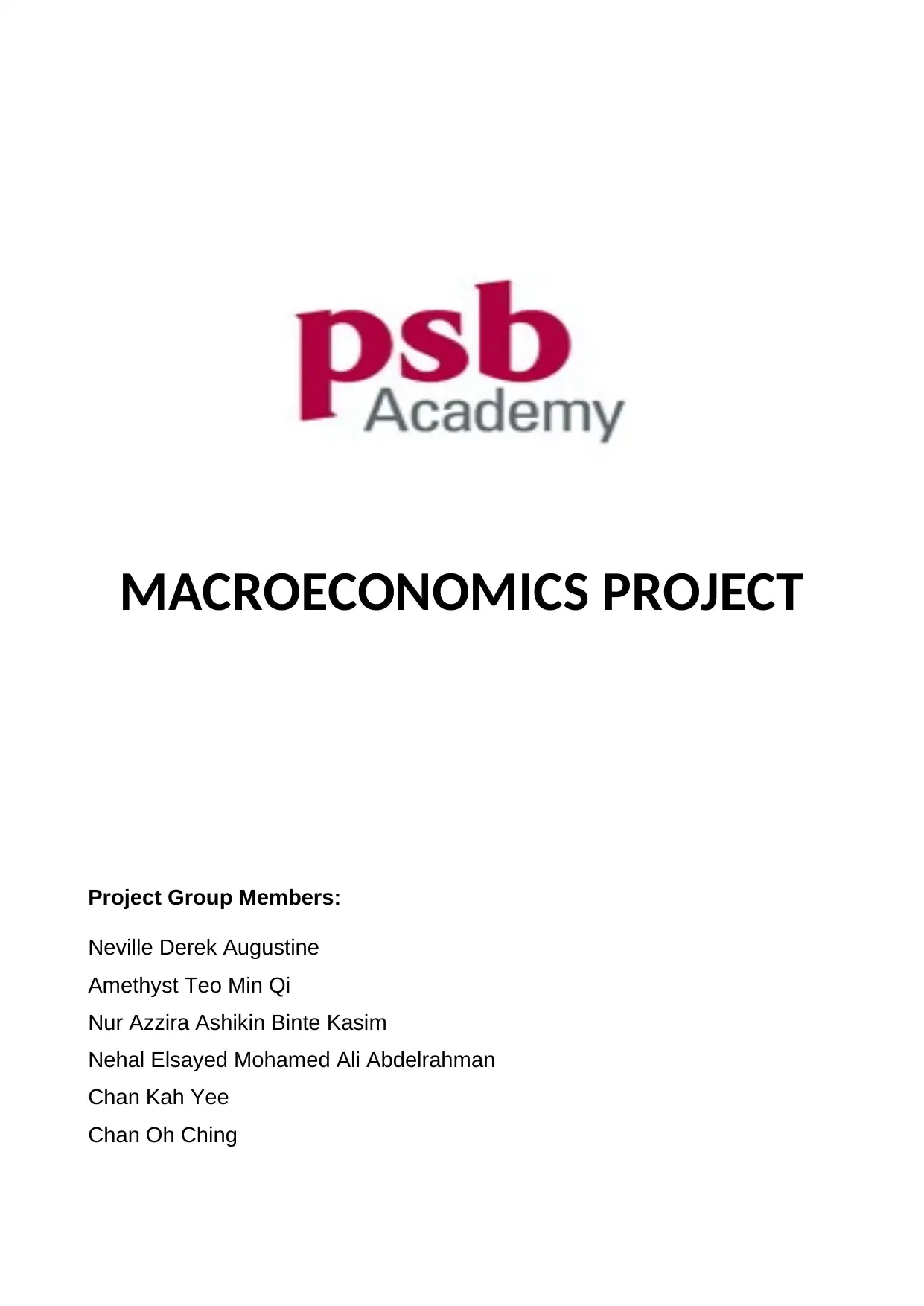
Project Group Members:
Neville Derek Augustine
Amethyst Teo Min Qi
Nur Azzira Ashikin Binte Kasim
Nehal Elsayed Mohamed Ali Abdelrahman
Chan Kah Yee
Chan Oh Ching
Paraphrase This Document
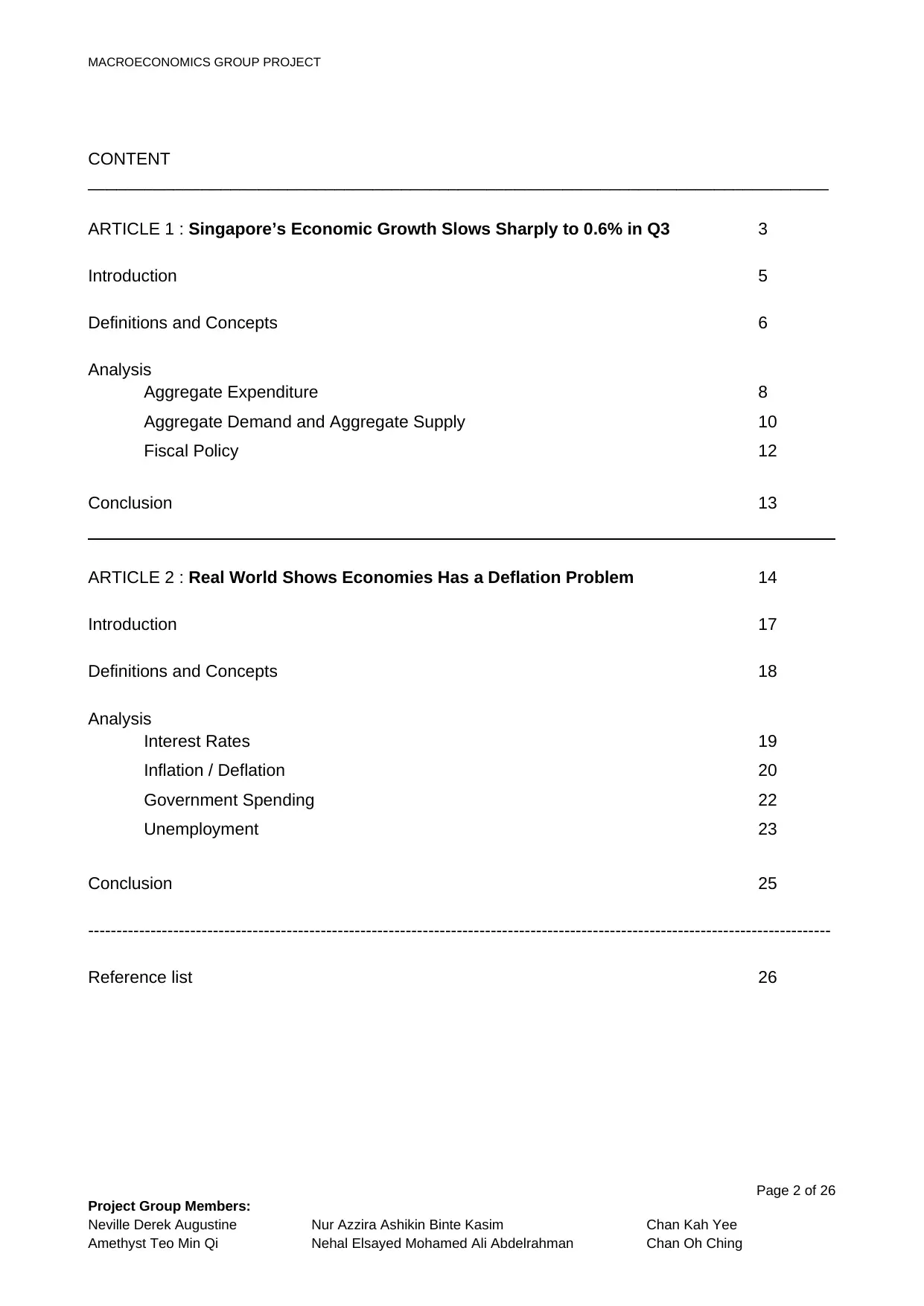
CONTENT
______________________________________________________________________________
ARTICLE 1 : Singapore’s Economic Growth Slows Sharply to 0.6% in Q3 3
Introduction 5
Definitions and Concepts 6
Analysis
Aggregate Expenditure 8
Aggregate Demand and Aggregate Supply 10
Fiscal Policy 12
Conclusion 13
ARTICLE 2 : Real World Shows Economies Has a Deflation Problem 14
Introduction 17
Definitions and Concepts 18
Analysis
Interest Rates 19
Inflation / Deflation 20
Government Spending 22
Unemployment 23
Conclusion 25
-----------------------------------------------------------------------------------------------------------------------------------
Reference list 26
Page 2 of 26
Project Group Members:
Neville Derek Augustine Nur Azzira Ashikin Binte Kasim Chan Kah Yee
Amethyst Teo Min Qi Nehal Elsayed Mohamed Ali Abdelrahman Chan Oh Ching
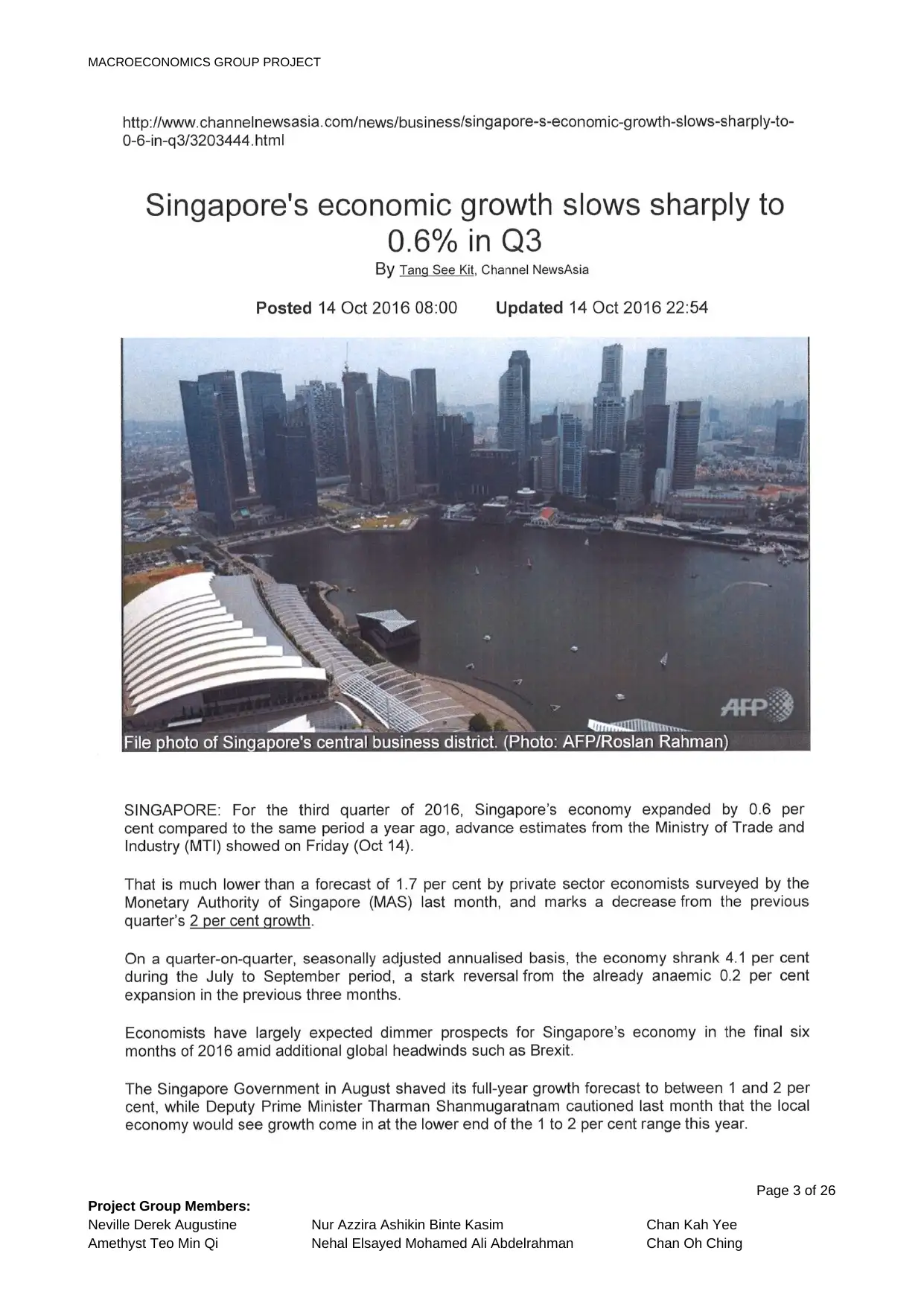
Page 3 of 26
Project Group Members:
Neville Derek Augustine Nur Azzira Ashikin Binte Kasim Chan Kah Yee
Amethyst Teo Min Qi Nehal Elsayed Mohamed Ali Abdelrahman Chan Oh Ching
⊘ This is a preview!⊘
Do you want full access?
Subscribe today to unlock all pages.

Trusted by 1+ million students worldwide
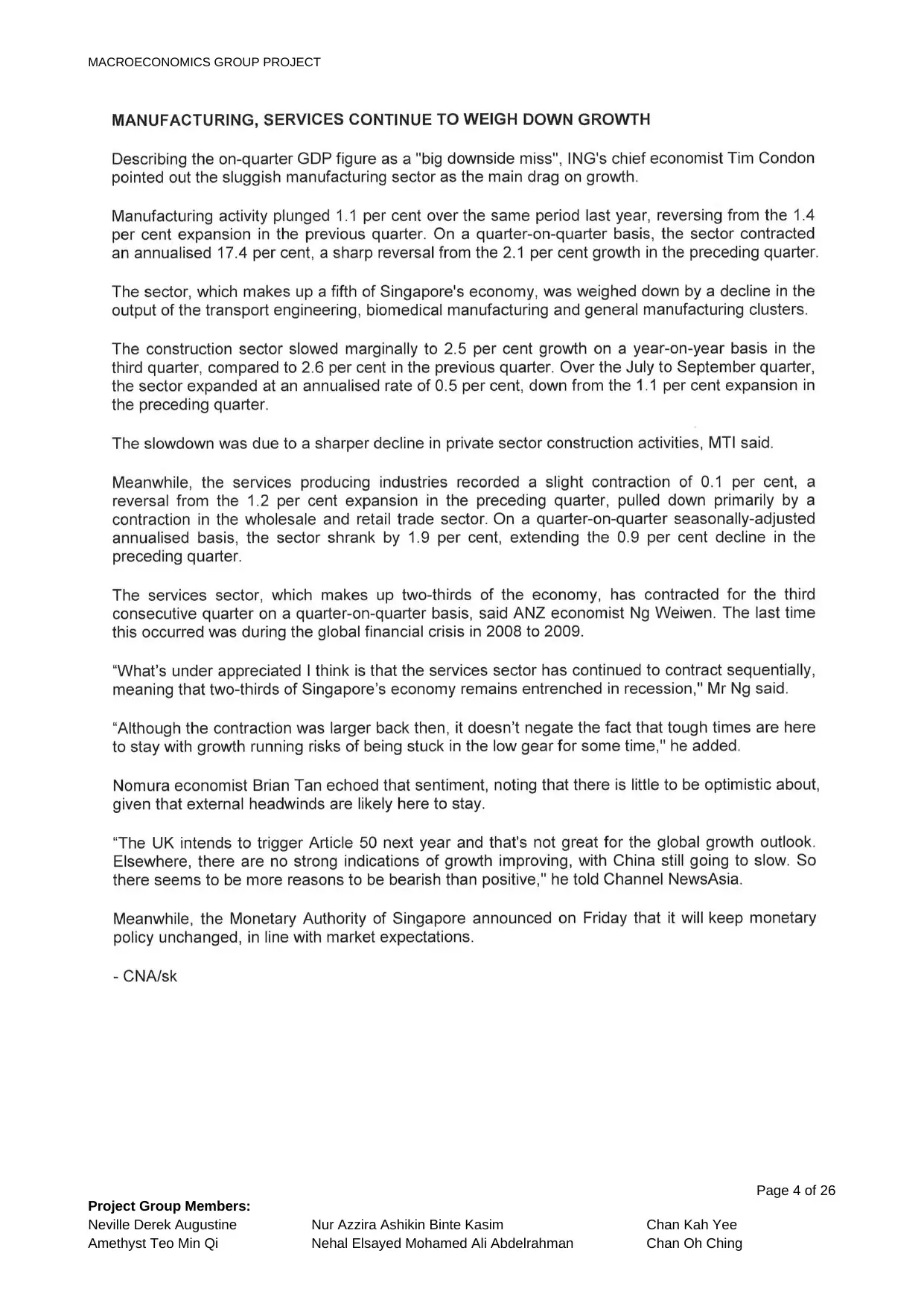
Page 4 of 26
Project Group Members:
Neville Derek Augustine Nur Azzira Ashikin Binte Kasim Chan Kah Yee
Amethyst Teo Min Qi Nehal Elsayed Mohamed Ali Abdelrahman Chan Oh Ching
Paraphrase This Document
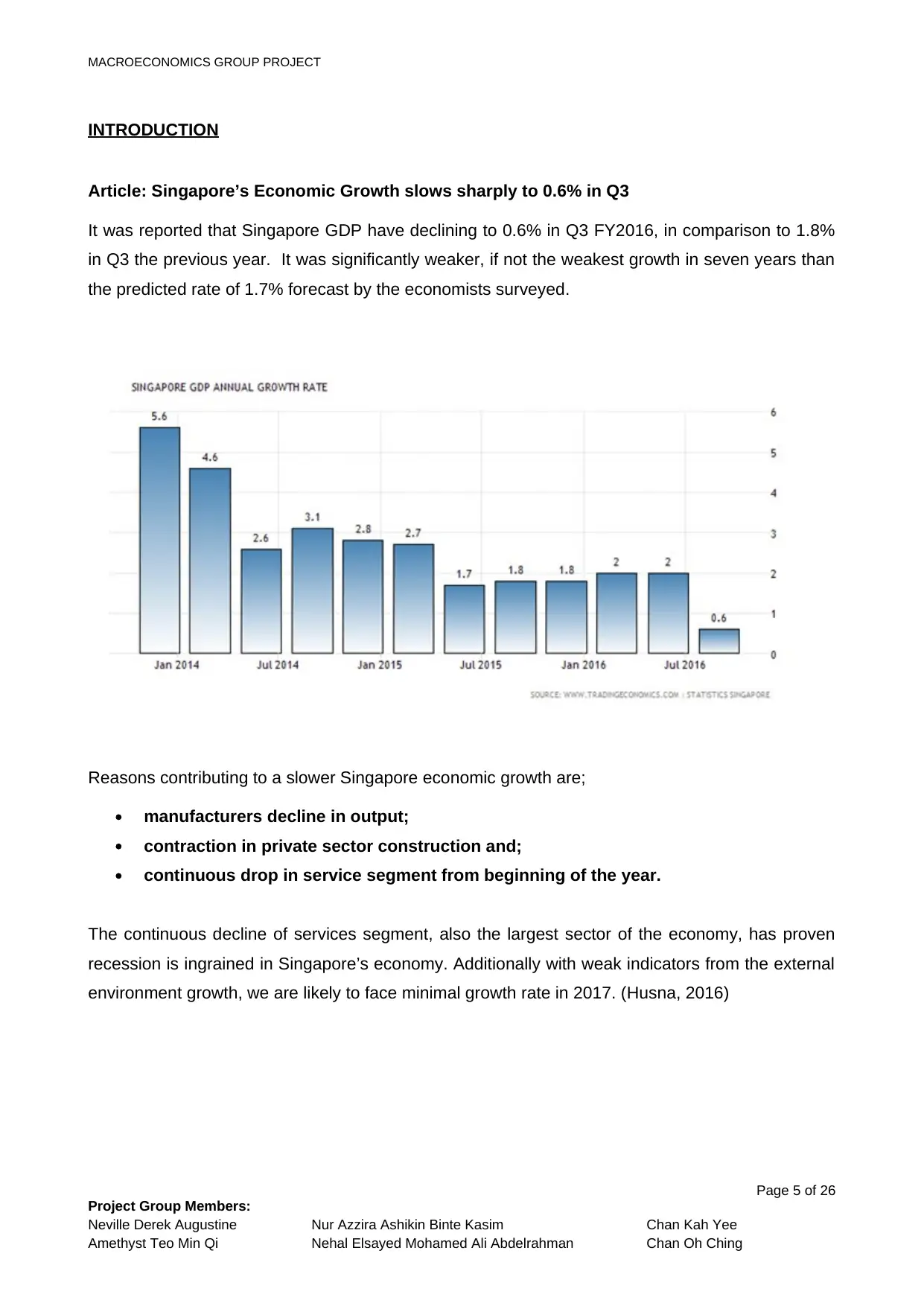
INTRODUCTION
Article: Singapore’s Economic Growth slows sharply to 0.6% in Q3
It was reported that Singapore GDP have declining to 0.6% in Q3 FY2016, in comparison to 1.8%
in Q3 the previous year. It was significantly weaker, if not the weakest growth in seven years than
the predicted rate of 1.7% forecast by the economists surveyed.
Reasons contributing to a slower Singapore economic growth are;
manufacturers decline in output;
contraction in private sector construction and;
continuous drop in service segment from beginning of the year.
The continuous decline of services segment, also the largest sector of the economy, has proven
recession is ingrained in Singapore’s economy. Additionally with weak indicators from the external
environment growth, we are likely to face minimal growth rate in 2017. (Husna, 2016)
Page 5 of 26
Project Group Members:
Neville Derek Augustine Nur Azzira Ashikin Binte Kasim Chan Kah Yee
Amethyst Teo Min Qi Nehal Elsayed Mohamed Ali Abdelrahman Chan Oh Ching
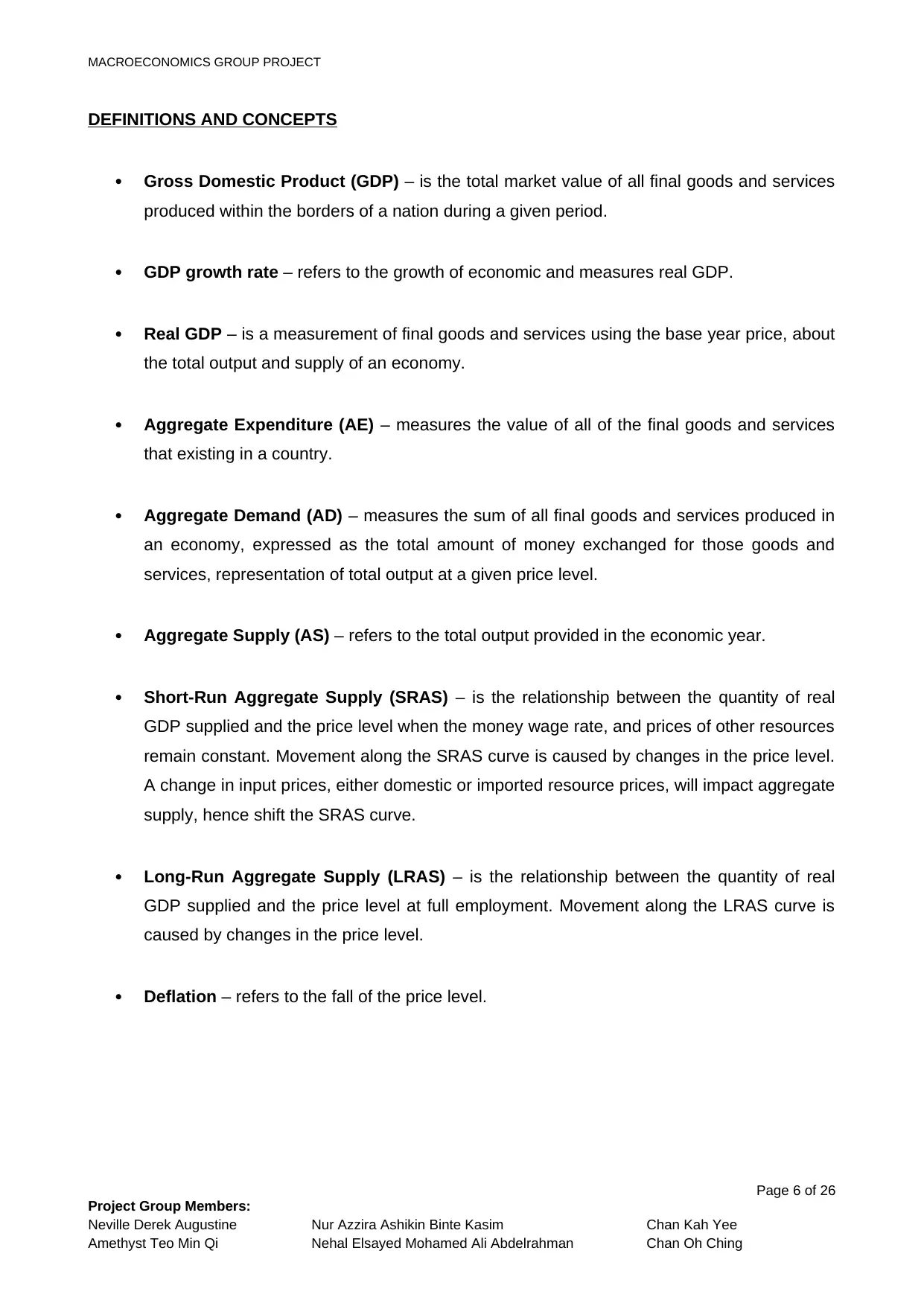
DEFINITIONS AND CONCEPTS
Gross Domestic Product (GDP) – is the total market value of all final goods and services
produced within the borders of a nation during a given period.
GDP growth rate – refers to the growth of economic and measures real GDP.
Real GDP – is a measurement of final goods and services using the base year price, about
the total output and supply of an economy.
Aggregate Expenditure (AE) – measures the value of all of the final goods and services
that existing in a country.
Aggregate Demand (AD) – measures the sum of all final goods and services produced in
an economy, expressed as the total amount of money exchanged for those goods and
services, representation of total output at a given price level.
Aggregate Supply (AS) – refers to the total output provided in the economic year.
Short-Run Aggregate Supply (SRAS) – is the relationship between the quantity of real
GDP supplied and the price level when the money wage rate, and prices of other resources
remain constant. Movement along the SRAS curve is caused by changes in the price level.
A change in input prices, either domestic or imported resource prices, will impact aggregate
supply, hence shift the SRAS curve.
Long-Run Aggregate Supply (LRAS) – is the relationship between the quantity of real
GDP supplied and the price level at full employment. Movement along the LRAS curve is
caused by changes in the price level.
Deflation – refers to the fall of the price level.
Page 6 of 26
Project Group Members:
Neville Derek Augustine Nur Azzira Ashikin Binte Kasim Chan Kah Yee
Amethyst Teo Min Qi Nehal Elsayed Mohamed Ali Abdelrahman Chan Oh Ching
⊘ This is a preview!⊘
Do you want full access?
Subscribe today to unlock all pages.

Trusted by 1+ million students worldwide
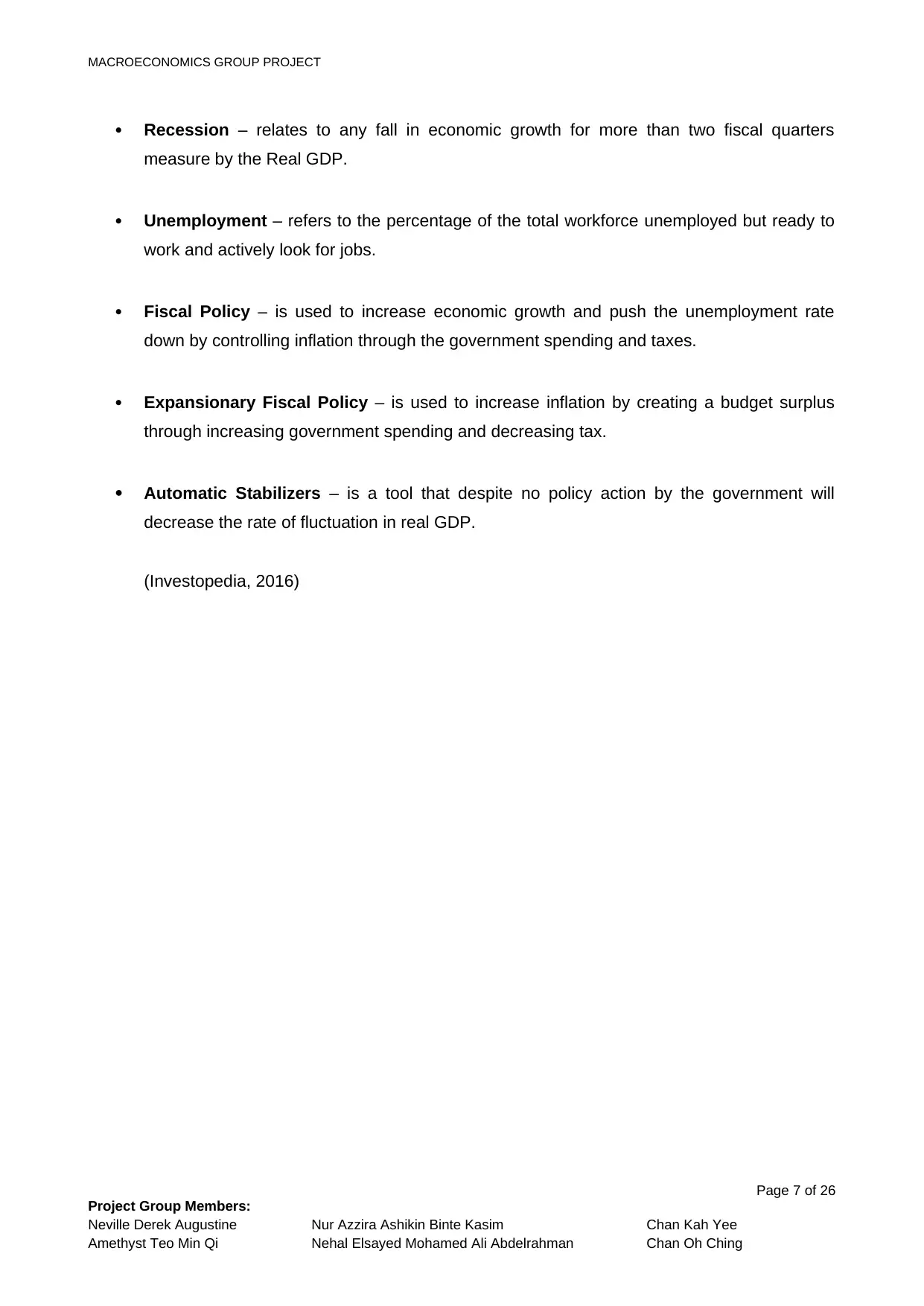
Recession – relates to any fall in economic growth for more than two fiscal quarters
measure by the Real GDP.
Unemployment – refers to the percentage of the total workforce unemployed but ready to
work and actively look for jobs.
Fiscal Policy – is used to increase economic growth and push the unemployment rate
down by controlling inflation through the government spending and taxes.
Expansionary Fiscal Policy – is used to increase inflation by creating a budget surplus
through increasing government spending and decreasing tax.
Automatic Stabilizers – is a tool that despite no policy action by the government will
decrease the rate of fluctuation in real GDP.
(Investopedia, 2016)
Page 7 of 26
Project Group Members:
Neville Derek Augustine Nur Azzira Ashikin Binte Kasim Chan Kah Yee
Amethyst Teo Min Qi Nehal Elsayed Mohamed Ali Abdelrahman Chan Oh Ching
Paraphrase This Document
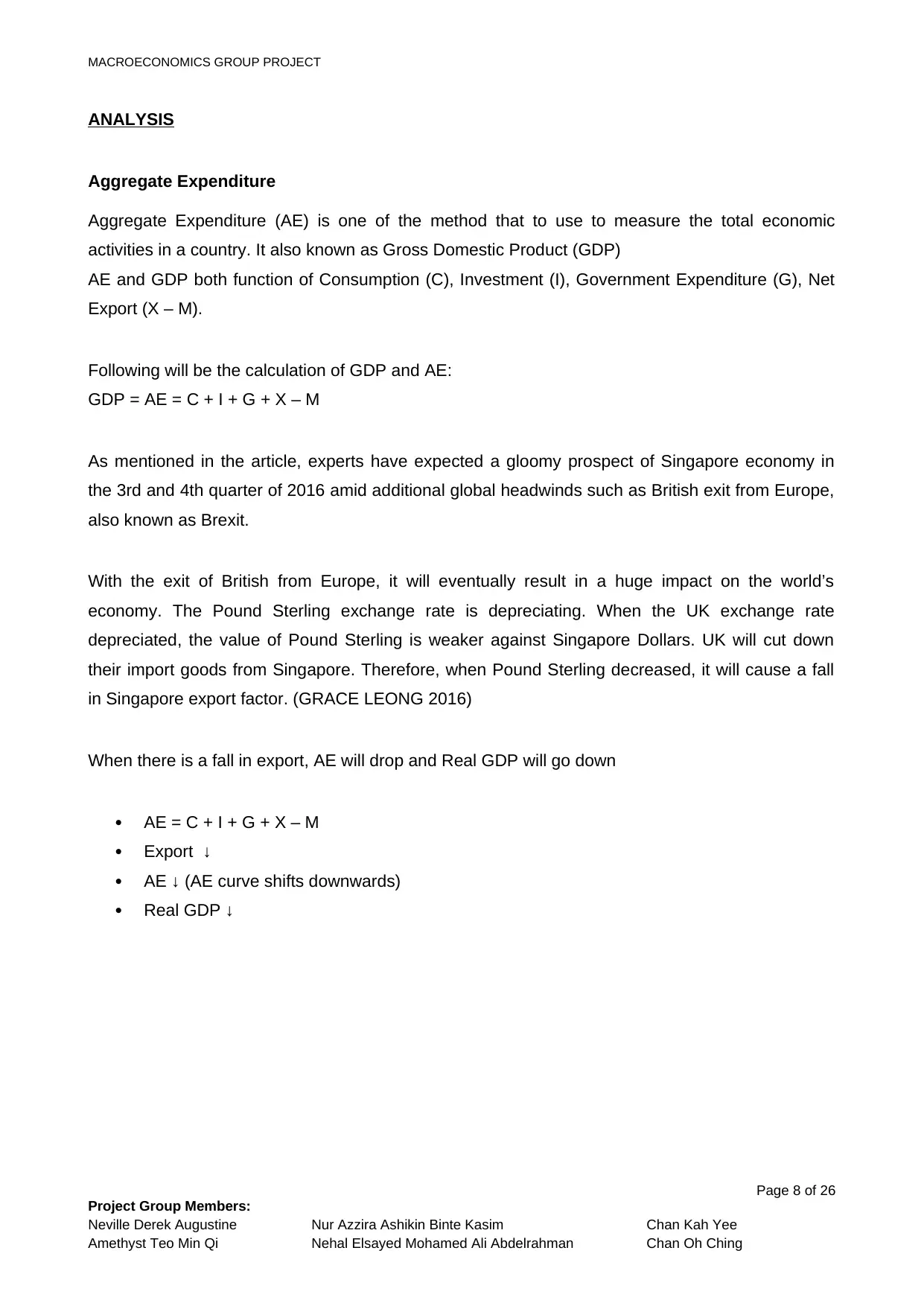
ANALYSIS
Aggregate Expenditure
Aggregate Expenditure (AE) is one of the method that to use to measure the total economic
activities in a country. It also known as Gross Domestic Product (GDP)
AE and GDP both function of Consumption (C), Investment (I), Government Expenditure (G), Net
Export (X – M).
Following will be the calculation of GDP and AE:
GDP = AE = C + I + G + X – M
As mentioned in the article, experts have expected a gloomy prospect of Singapore economy in
the 3rd and 4th quarter of 2016 amid additional global headwinds such as British exit from Europe,
also known as Brexit.
With the exit of British from Europe, it will eventually result in a huge impact on the world’s
economy. The Pound Sterling exchange rate is depreciating. When the UK exchange rate
depreciated, the value of Pound Sterling is weaker against Singapore Dollars. UK will cut down
their import goods from Singapore. Therefore, when Pound Sterling decreased, it will cause a fall
in Singapore export factor. (GRACE LEONG 2016)
When there is a fall in export, AE will drop and Real GDP will go down
AE = C + I + G + X – M
Export ↓
AE ↓ (AE curve shifts downwards)
Real GDP ↓
Page 8 of 26
Project Group Members:
Neville Derek Augustine Nur Azzira Ashikin Binte Kasim Chan Kah Yee
Amethyst Teo Min Qi Nehal Elsayed Mohamed Ali Abdelrahman Chan Oh Ching
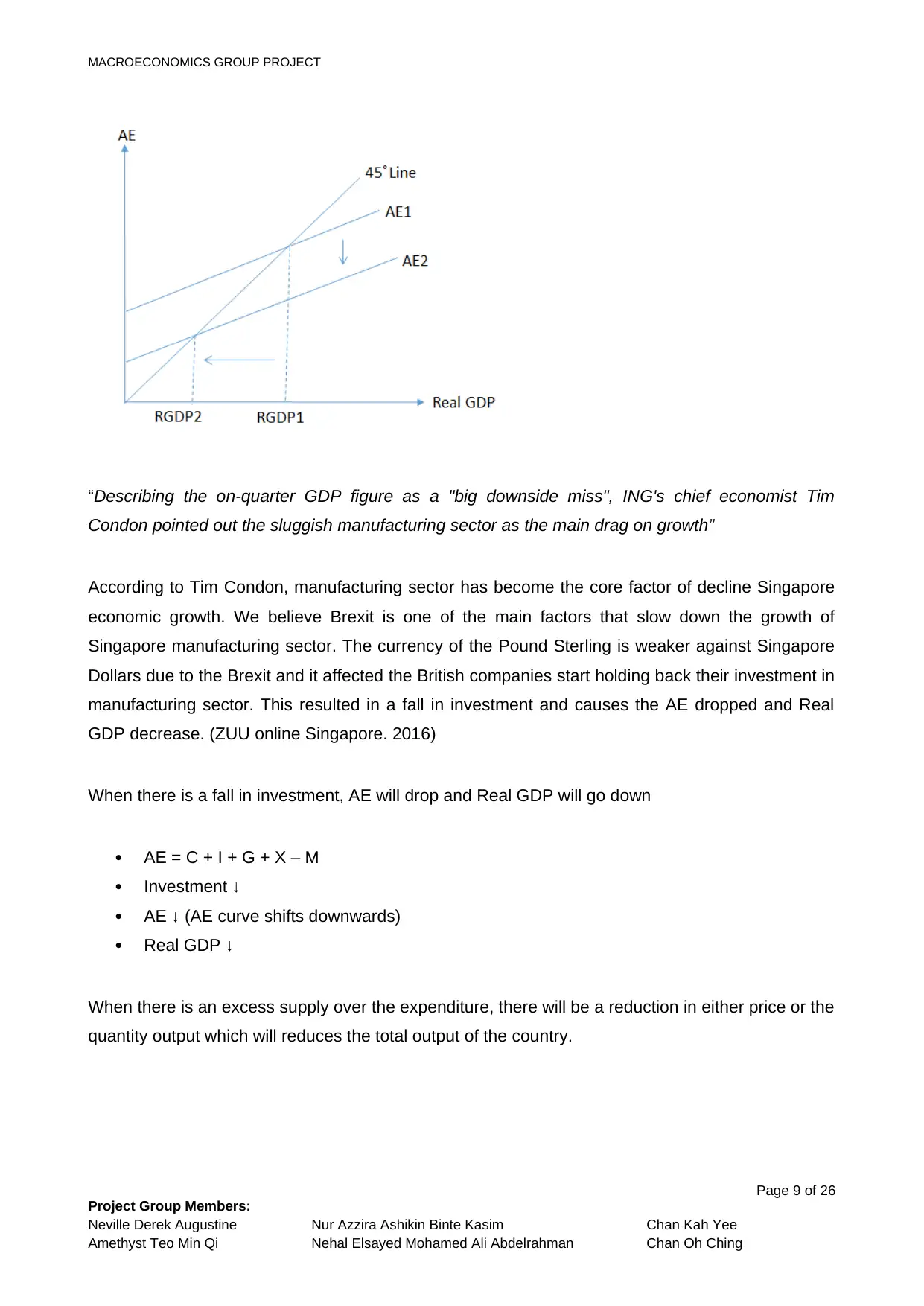
“Describing the on-quarter GDP figure as a "big downside miss", ING's chief economist Tim
Condon pointed out the sluggish manufacturing sector as the main drag on growth”
According to Tim Condon, manufacturing sector has become the core factor of decline Singapore
economic growth. We believe Brexit is one of the main factors that slow down the growth of
Singapore manufacturing sector. The currency of the Pound Sterling is weaker against Singapore
Dollars due to the Brexit and it affected the British companies start holding back their investment in
manufacturing sector. This resulted in a fall in investment and causes the AE dropped and Real
GDP decrease. (ZUU online Singapore. 2016)
When there is a fall in investment, AE will drop and Real GDP will go down
AE = C + I + G + X – M
Investment ↓
AE ↓ (AE curve shifts downwards)
Real GDP ↓
When there is an excess supply over the expenditure, there will be a reduction in either price or the
quantity output which will reduces the total output of the country.
Page 9 of 26
Project Group Members:
Neville Derek Augustine Nur Azzira Ashikin Binte Kasim Chan Kah Yee
Amethyst Teo Min Qi Nehal Elsayed Mohamed Ali Abdelrahman Chan Oh Ching
⊘ This is a preview!⊘
Do you want full access?
Subscribe today to unlock all pages.

Trusted by 1+ million students worldwide

Aggregate Demand and Aggregate Supply
The main drag on Singapore’s economic growth is a downturn in manufacturing sector.
“Manufacturing activity plunged 1.1 per cent over the same period last year, reversing from the 1.4
per cent expansion in the previous quarter”. The transport engineering, biomedical manufacturing
and general manufacturing clusters output decline has dragged down this sector. Uncertain global
financial markets and weak global demand has resulted in manufacturing contraction in Singapore.
It has a direct impact on the decline in Singapore's exports. When overseas demand weakens,
Singapore's exports fall, aggregate demand and real GDP will decline. Insufficient demand will
lead to a decrease in productivity. Subsequently, businesses will implement cost reduction and
layoffs to sustain their operations.
Manufacturing Sector Downturn
AD = C + I + G + X - M
Exports ↓
AD ↓ (AD curve shifts leftwards)
Price Level ↓ (Deflation)
Real GDP ↓ (Recession, High Unemployment)
“The construction sector slowed marginally to 2.5 per cent growth on a year-on-year basis in the
third quarter, compared to 2.6 per cent in the previous quarter”. This was mainly due to a
significant reduction in private sector construction activities. When the global economy is unstable,
the construction sector has also been hit. People are more cautious about spending money on
property and investment. Businesses stop expanding and reduce their investment and borrowing,
this will affect the decline in corporate bank loans. Some businesses suffered loss of profits or
even shut down. When investment is reduced, aggregate demand and real GDP will decline.
Furthermore, people will face a lack of employment opportunities.
Construction Sector Slowdown
AD = C + I + G + X - M
Investment ↓
AD ↓ (AD curve shifts leftwards)
Price Level ↓ (Deflation)
Real GDP ↓ (Recession, High Unemployment)
Page 10 of 26
Project Group Members:
Neville Derek Augustine Nur Azzira Ashikin Binte Kasim Chan Kah Yee
Amethyst Teo Min Qi Nehal Elsayed Mohamed Ali Abdelrahman Chan Oh Ching
Paraphrase This Document
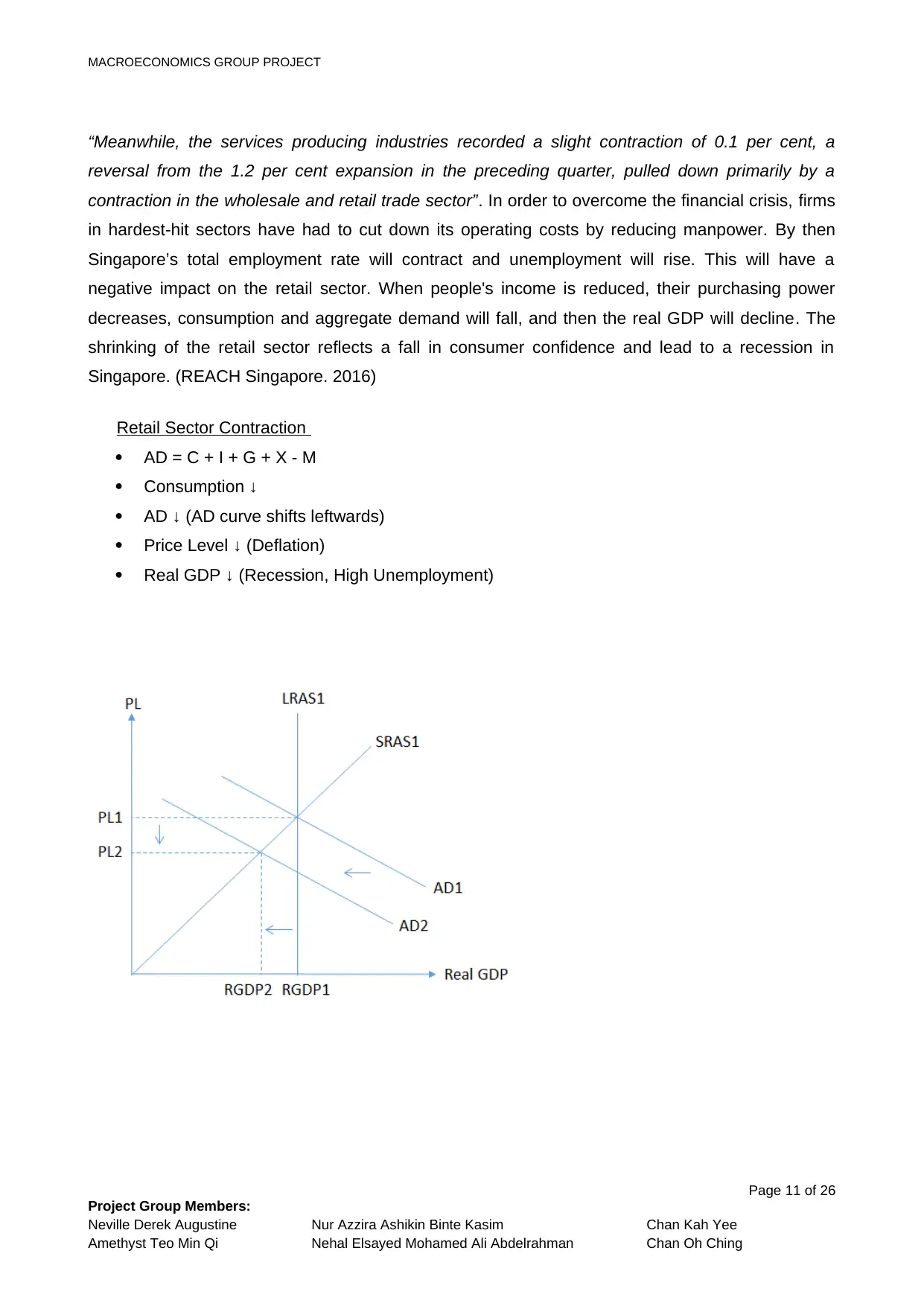
“Meanwhile, the services producing industries recorded a slight contraction of 0.1 per cent, a
reversal from the 1.2 per cent expansion in the preceding quarter, pulled down primarily by a
contraction in the wholesale and retail trade sector”. In order to overcome the financial crisis, firms
in hardest-hit sectors have had to cut down its operating costs by reducing manpower. By then
Singapore’s total employment rate will contract and unemployment will rise. This will have a
negative impact on the retail sector. When people's income is reduced, their purchasing power
decreases, consumption and aggregate demand will fall, and then the real GDP will decline. The
shrinking of the retail sector reflects a fall in consumer confidence and lead to a recession in
Singapore. (REACH Singapore. 2016)
Retail Sector Contraction
AD = C + I + G + X - M
Consumption ↓
AD ↓ (AD curve shifts leftwards)
Price Level ↓ (Deflation)
Real GDP ↓ (Recession, High Unemployment)
Page 11 of 26
Project Group Members:
Neville Derek Augustine Nur Azzira Ashikin Binte Kasim Chan Kah Yee
Amethyst Teo Min Qi Nehal Elsayed Mohamed Ali Abdelrahman Chan Oh Ching

Fiscal Policy
In a recession, Singapore government can implement expansionary fiscal policy, which includes
increase government spending and/or decrease taxes to reduce unemployment and help the
economy out of recession. (investopedia. 2016)
The government can spend more on infrastructure spending by building transportation and
communications systems, and public institutions e.g. schools, post offices, prisons and so
forth. When government spending increases, aggregate demand will also increase, this will help to
create jobs and wages, and reduce cyclical unemployment.
At the same time, the government may reduce corporate income tax and personal income tax to
boost spending. When the corporate income tax rate is low, firms are confident that there are more
profit margins to expand their business and investment. By then, people will have more jobs and
overall employment rate will rise. Business expansion and investment will directly drive economic
growth. (economicshelp. 2016)
Lowering personal income tax may increase consumers spending. When people are paying less in
taxes, they have more disposable income to consume and invest. When the consumer's
consumption level is high, aggregate demand and real GDP will increase, this may lead to higher
economic growth.
Expansionary Fiscal Policy
Page 12 of 26
Project Group Members:
Neville Derek Augustine Nur Azzira Ashikin Binte Kasim Chan Kah Yee
Amethyst Teo Min Qi Nehal Elsayed Mohamed Ali Abdelrahman Chan Oh Ching
⊘ This is a preview!⊘
Do you want full access?
Subscribe today to unlock all pages.

Trusted by 1+ million students worldwide
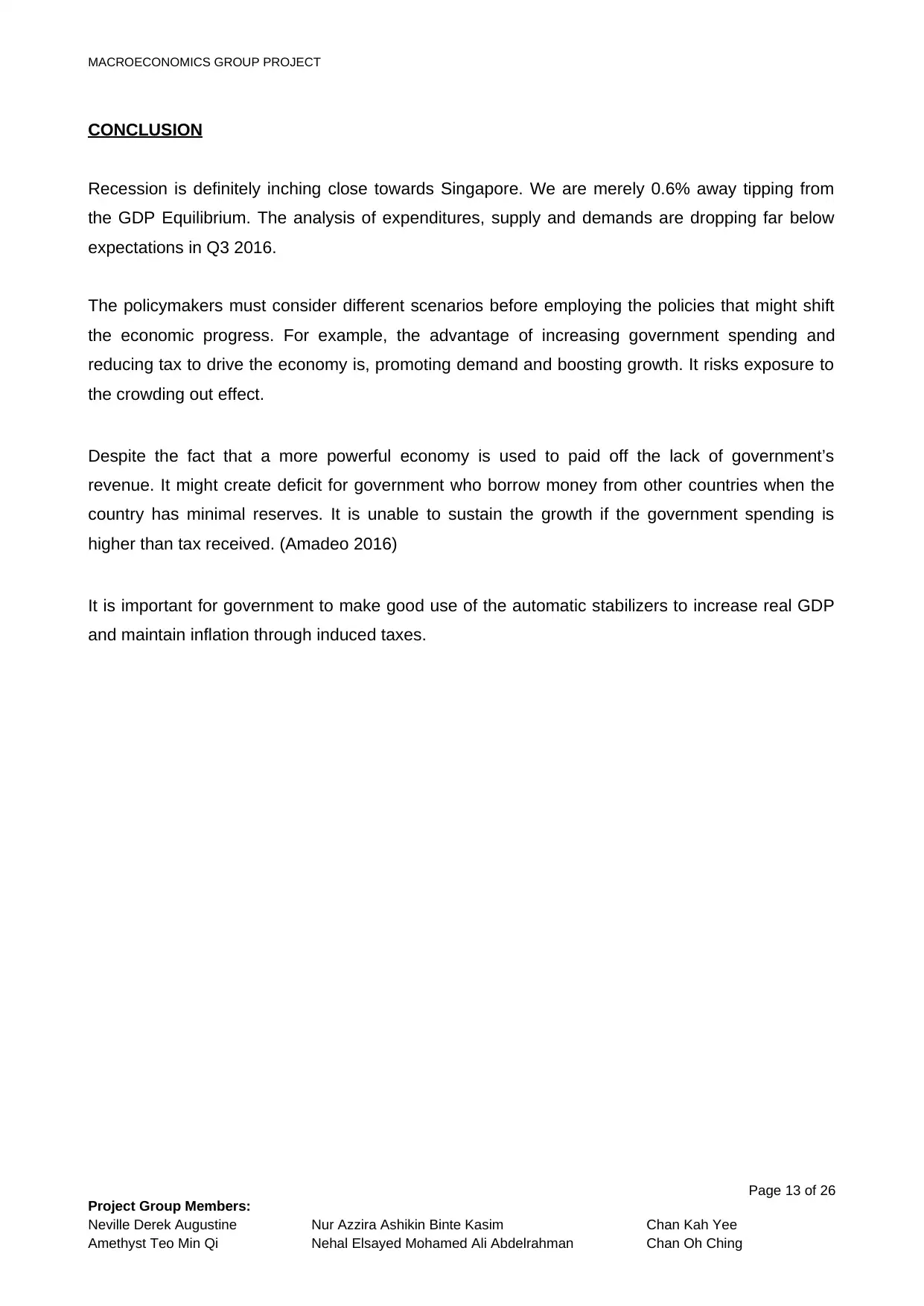
CONCLUSION
Recession is definitely inching close towards Singapore. We are merely 0.6% away tipping from
the GDP Equilibrium. The analysis of expenditures, supply and demands are dropping far below
expectations in Q3 2016.
The policymakers must consider different scenarios before employing the policies that might shift
the economic progress. For example, the advantage of increasing government spending and
reducing tax to drive the economy is, promoting demand and boosting growth. It risks exposure to
the crowding out effect.
Despite the fact that a more powerful economy is used to paid off the lack of government’s
revenue. It might create deficit for government who borrow money from other countries when the
country has minimal reserves. It is unable to sustain the growth if the government spending is
higher than tax received. (Amadeo 2016)
It is important for government to make good use of the automatic stabilizers to increase real GDP
and maintain inflation through induced taxes.
Page 13 of 26
Project Group Members:
Neville Derek Augustine Nur Azzira Ashikin Binte Kasim Chan Kah Yee
Amethyst Teo Min Qi Nehal Elsayed Mohamed Ali Abdelrahman Chan Oh Ching
Paraphrase This Document
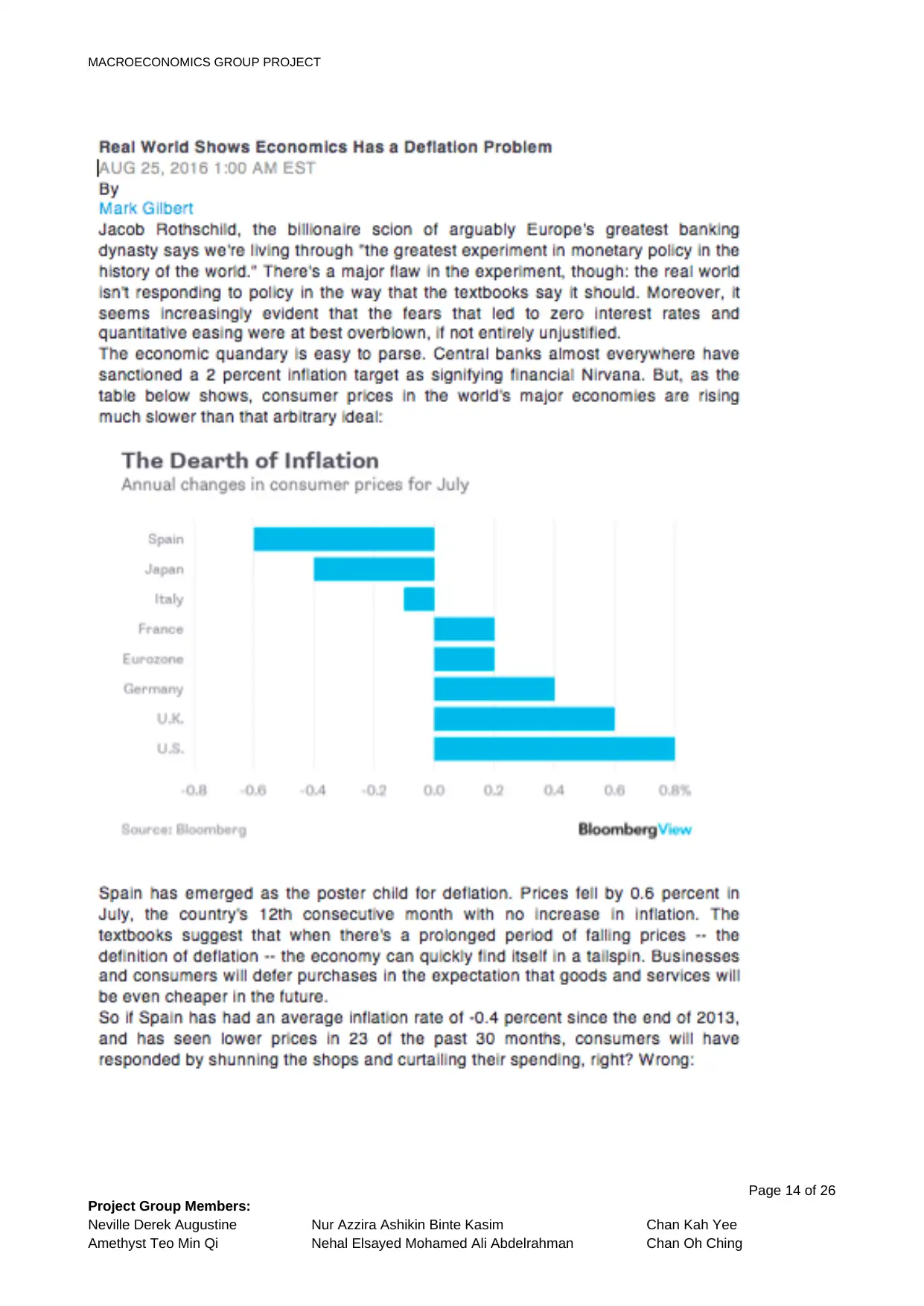
Page 14 of 26
Project Group Members:
Neville Derek Augustine Nur Azzira Ashikin Binte Kasim Chan Kah Yee
Amethyst Teo Min Qi Nehal Elsayed Mohamed Ali Abdelrahman Chan Oh Ching
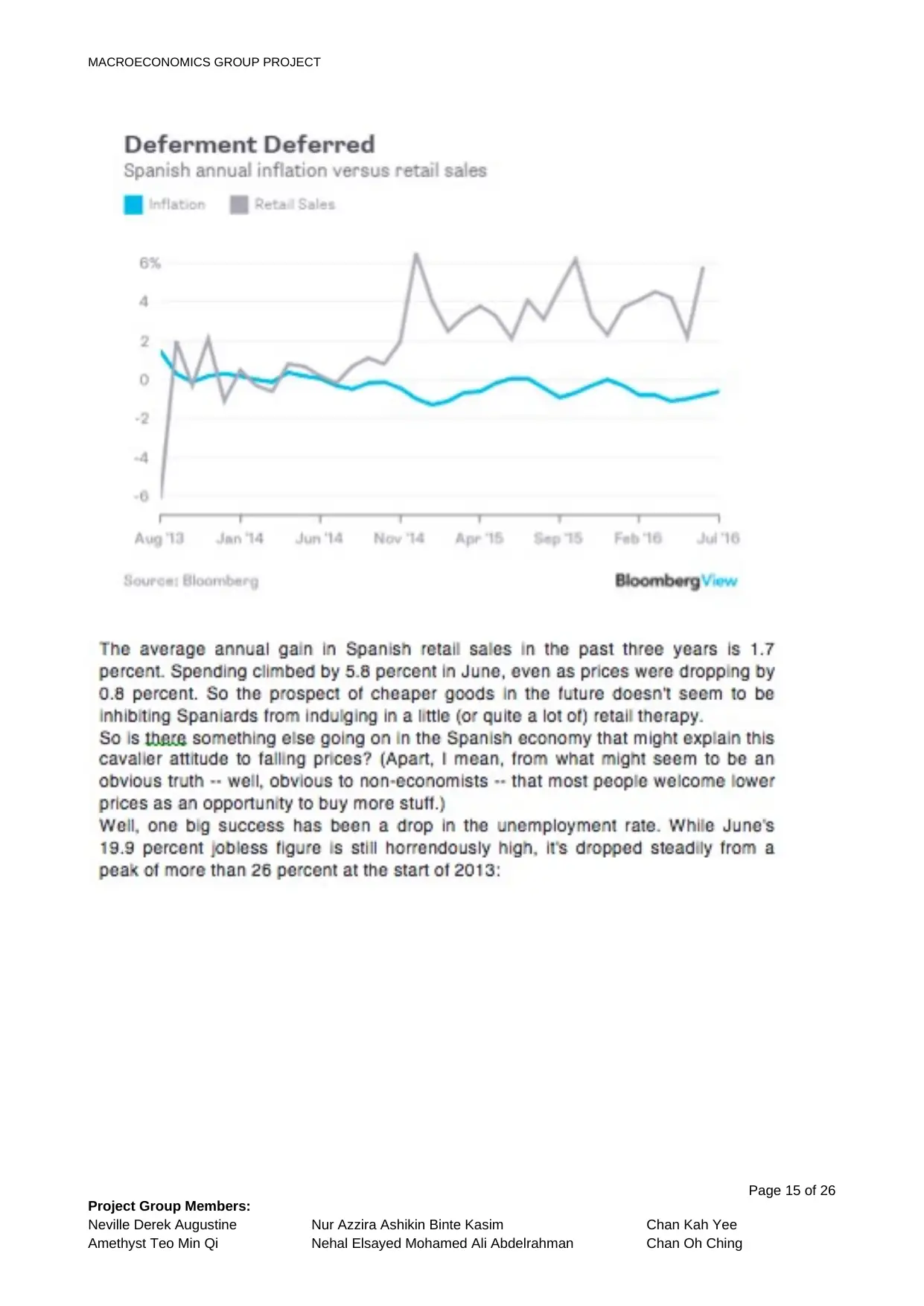
Page 15 of 26
Project Group Members:
Neville Derek Augustine Nur Azzira Ashikin Binte Kasim Chan Kah Yee
Amethyst Teo Min Qi Nehal Elsayed Mohamed Ali Abdelrahman Chan Oh Ching
⊘ This is a preview!⊘
Do you want full access?
Subscribe today to unlock all pages.

Trusted by 1+ million students worldwide
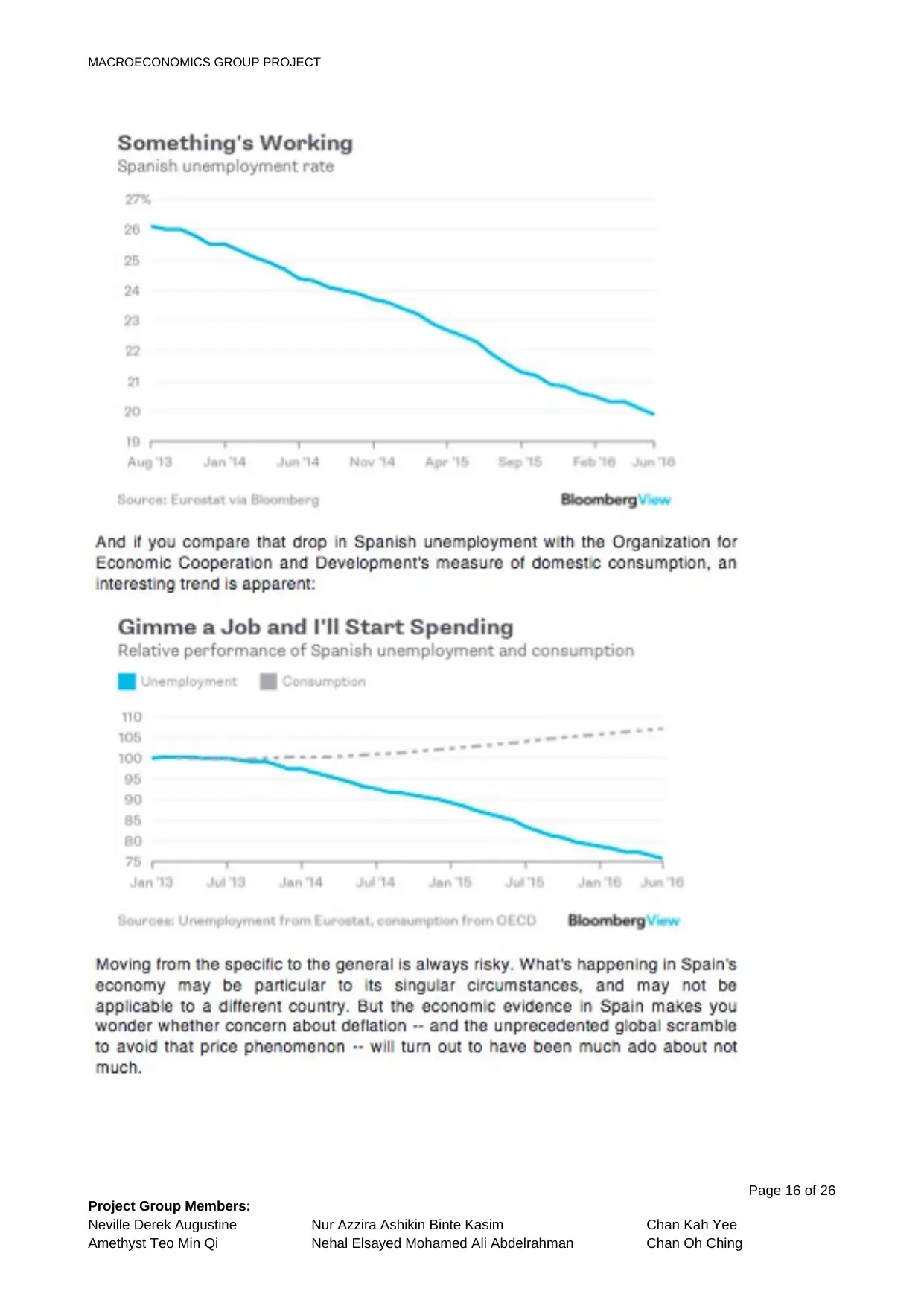
Page 16 of 26
Project Group Members:
Neville Derek Augustine Nur Azzira Ashikin Binte Kasim Chan Kah Yee
Amethyst Teo Min Qi Nehal Elsayed Mohamed Ali Abdelrahman Chan Oh Ching
Paraphrase This Document
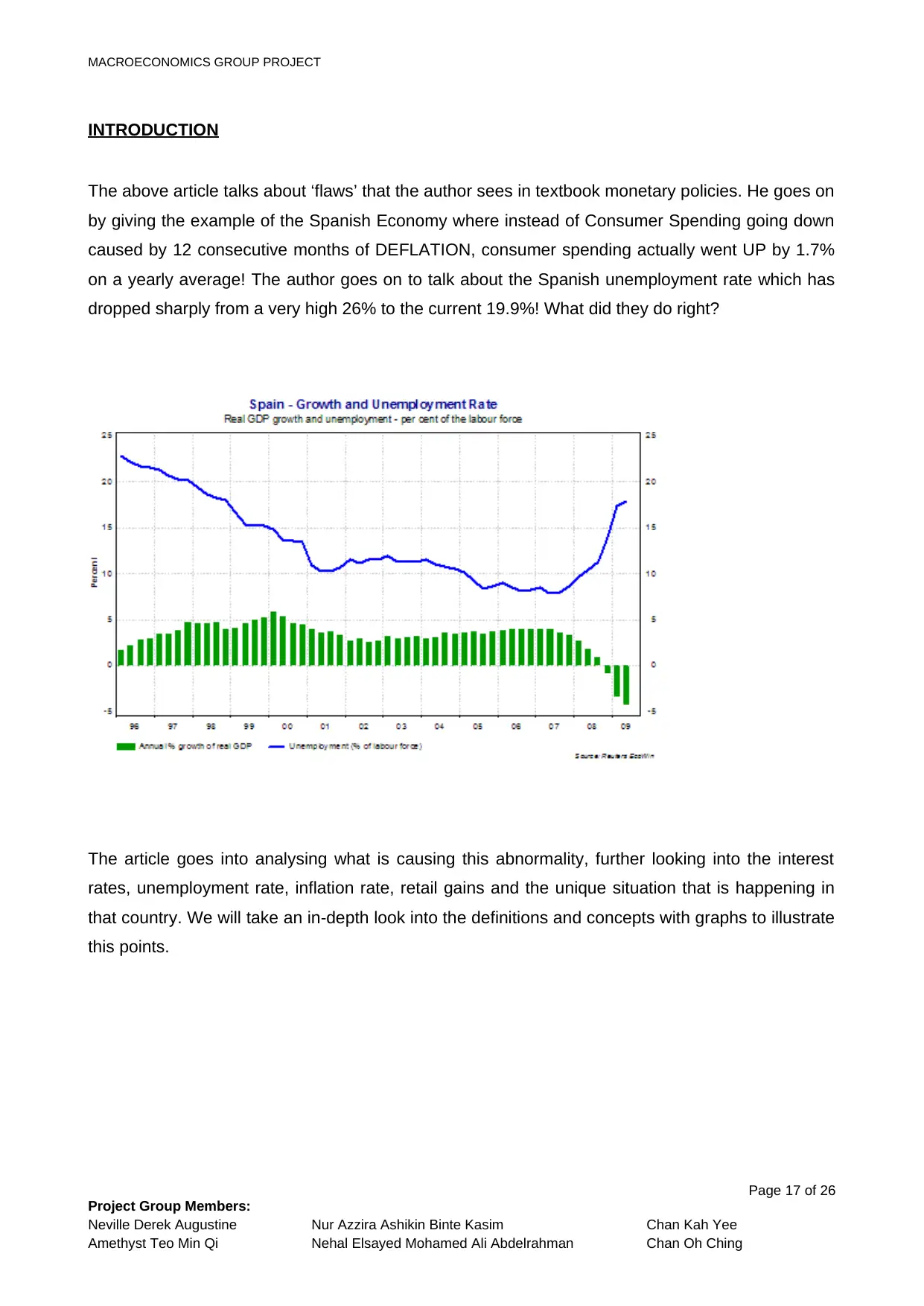
INTRODUCTION
The above article talks about ‘flaws’ that the author sees in textbook monetary policies. He goes on
by giving the example of the Spanish Economy where instead of Consumer Spending going down
caused by 12 consecutive months of DEFLATION, consumer spending actually went UP by 1.7%
on a yearly average! The author goes on to talk about the Spanish unemployment rate which has
dropped sharply from a very high 26% to the current 19.9%! What did they do right?
The article goes into analysing what is causing this abnormality, further looking into the interest
rates, unemployment rate, inflation rate, retail gains and the unique situation that is happening in
that country. We will take an in-depth look into the definitions and concepts with graphs to illustrate
this points.
Page 17 of 26
Project Group Members:
Neville Derek Augustine Nur Azzira Ashikin Binte Kasim Chan Kah Yee
Amethyst Teo Min Qi Nehal Elsayed Mohamed Ali Abdelrahman Chan Oh Ching
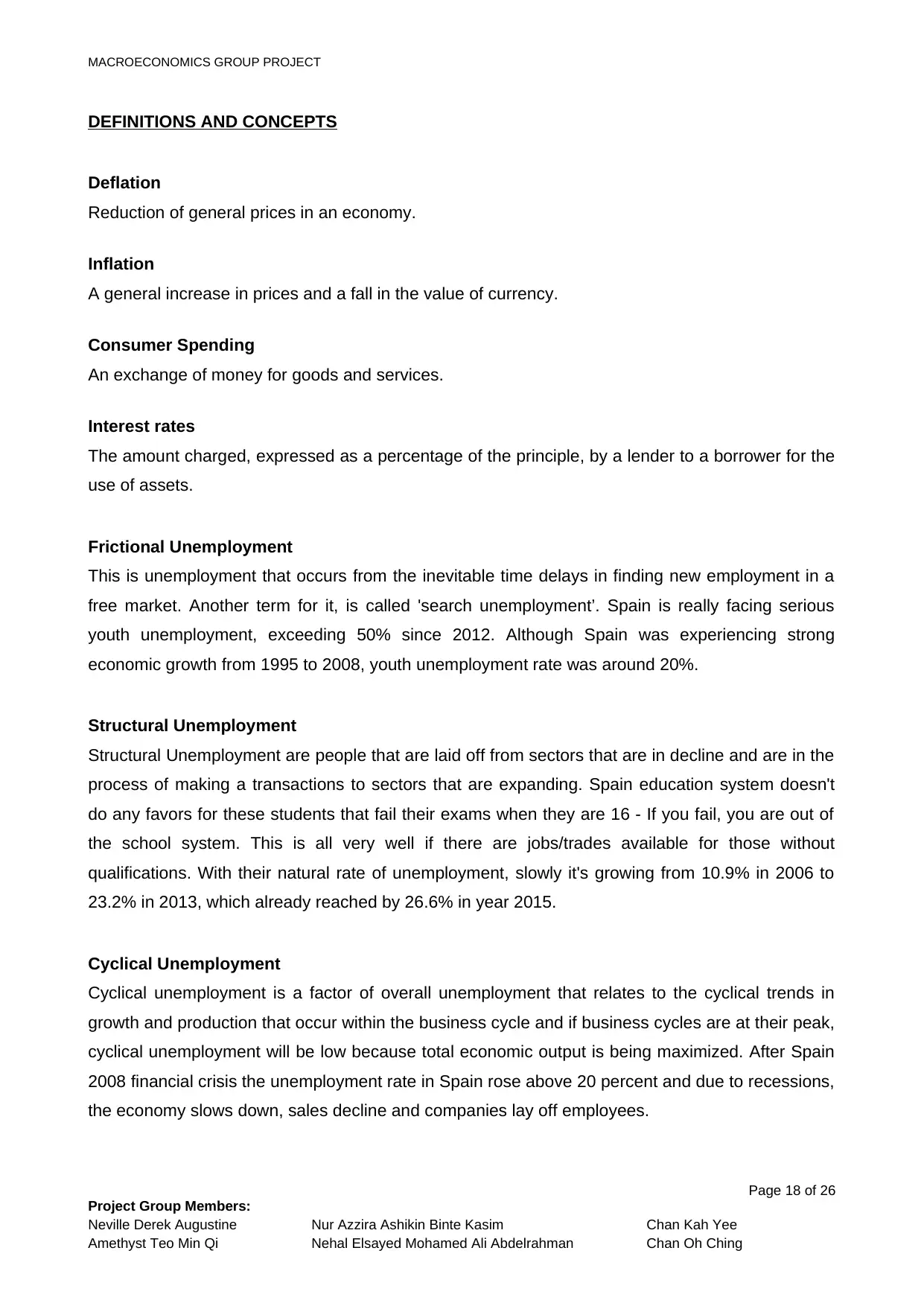
DEFINITIONS AND CONCEPTS
Deflation
Reduction of general prices in an economy.
Inflation
A general increase in prices and a fall in the value of currency.
Consumer Spending
An exchange of money for goods and services.
Interest rates
The amount charged, expressed as a percentage of the principle, by a lender to a borrower for the
use of assets.
Frictional Unemployment
This is unemployment that occurs from the inevitable time delays in finding new employment in a
free market. Another term for it, is called 'search unemployment’. Spain is really facing serious
youth unemployment, exceeding 50% since 2012. Although Spain was experiencing strong
economic growth from 1995 to 2008, youth unemployment rate was around 20%.
Structural Unemployment
Structural Unemployment are people that are laid off from sectors that are in decline and are in the
process of making a transactions to sectors that are expanding. Spain education system doesn't
do any favors for these students that fail their exams when they are 16 - If you fail, you are out of
the school system. This is all very well if there are jobs/trades available for those without
qualifications. With their natural rate of unemployment, slowly it's growing from 10.9% in 2006 to
23.2% in 2013, which already reached by 26.6% in year 2015.
Cyclical Unemployment
Cyclical unemployment is a factor of overall unemployment that relates to the cyclical trends in
growth and production that occur within the business cycle and if business cycles are at their peak,
cyclical unemployment will be low because total economic output is being maximized. After Spain
2008 financial crisis the unemployment rate in Spain rose above 20 percent and due to recessions,
the economy slows down, sales decline and companies lay off employees.
Page 18 of 26
Project Group Members:
Neville Derek Augustine Nur Azzira Ashikin Binte Kasim Chan Kah Yee
Amethyst Teo Min Qi Nehal Elsayed Mohamed Ali Abdelrahman Chan Oh Ching
⊘ This is a preview!⊘
Do you want full access?
Subscribe today to unlock all pages.

Trusted by 1+ million students worldwide

ANALYSIS
Interest Rates
In any typical situation, when the interest rate is set at 0%, it is highly likely that there is deflation,
unemployment and slow growth present. On the positive side, a zero interest rate promotes
spending and investments.
Interest rates decrease > C increases > I increases
Page 19 of 26
Project Group Members:
Neville Derek Augustine Nur Azzira Ashikin Binte Kasim Chan Kah Yee
Amethyst Teo Min Qi Nehal Elsayed Mohamed Ali Abdelrahman Chan Oh Ching
Paraphrase This Document
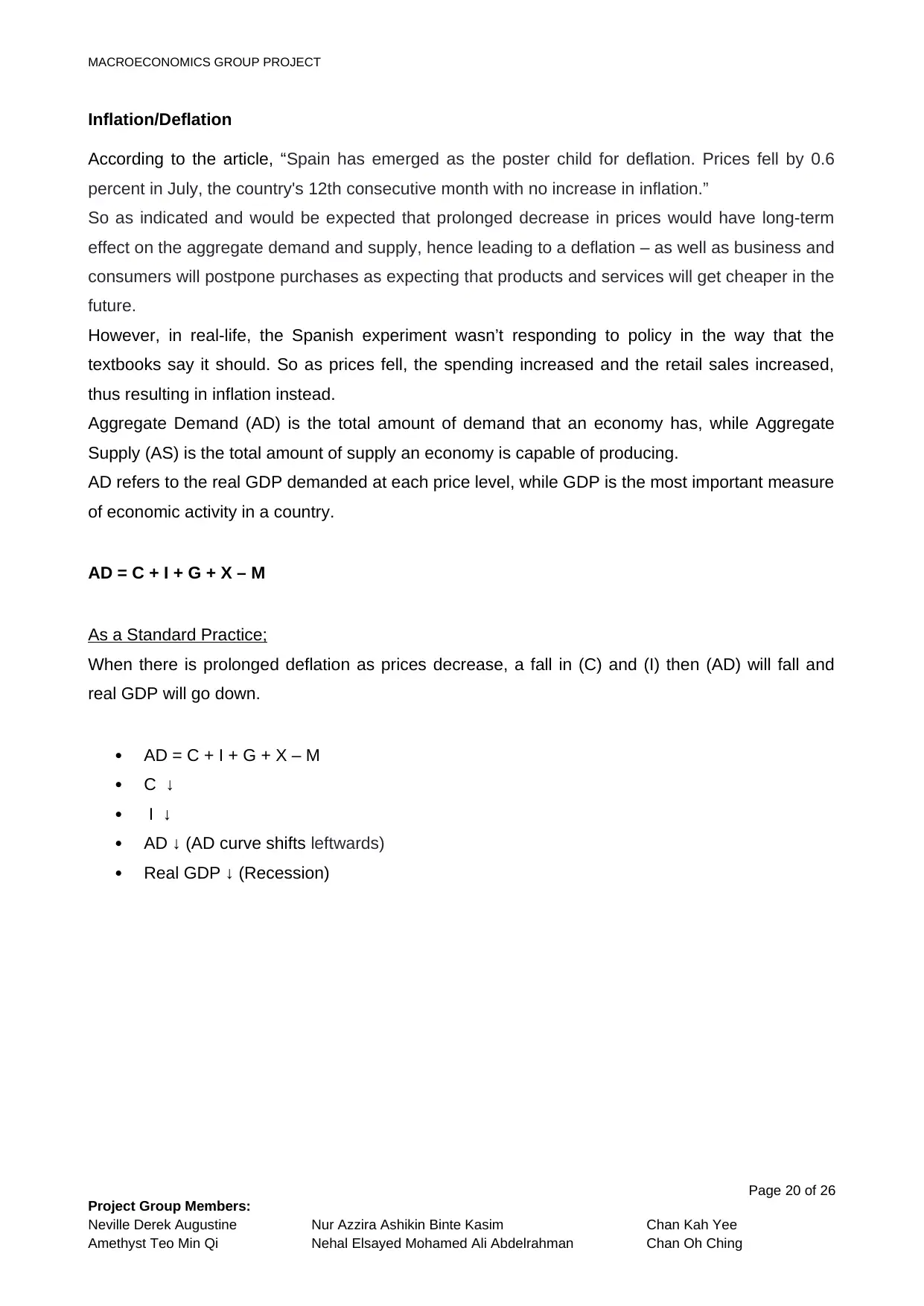
Inflation/Deflation
According to the article, “Spain has emerged as the poster child for deflation. Prices fell by 0.6
percent in July, the country's 12th consecutive month with no increase in inflation.”
So as indicated and would be expected that prolonged decrease in prices would have long-term
effect on the aggregate demand and supply, hence leading to a deflation – as well as business and
consumers will postpone purchases as expecting that products and services will get cheaper in the
future.
However, in real-life, the Spanish experiment wasn’t responding to policy in the way that the
textbooks say it should. So as prices fell, the spending increased and the retail sales increased,
thus resulting in inflation instead.
Aggregate Demand (AD) is the total amount of demand that an economy has, while Aggregate
Supply (AS) is the total amount of supply an economy is capable of producing.
AD refers to the real GDP demanded at each price level, while GDP is the most important measure
of economic activity in a country.
AD = C + I + G + X – M
As a Standard Practice;
When there is prolonged deflation as prices decrease, a fall in (C) and (I) then (AD) will fall and
real GDP will go down.
AD = C + I + G + X – M
C ↓
I ↓
AD ↓ (AD curve shifts leftwards)
Real GDP ↓ (Recession)
Page 20 of 26
Project Group Members:
Neville Derek Augustine Nur Azzira Ashikin Binte Kasim Chan Kah Yee
Amethyst Teo Min Qi Nehal Elsayed Mohamed Ali Abdelrahman Chan Oh Ching
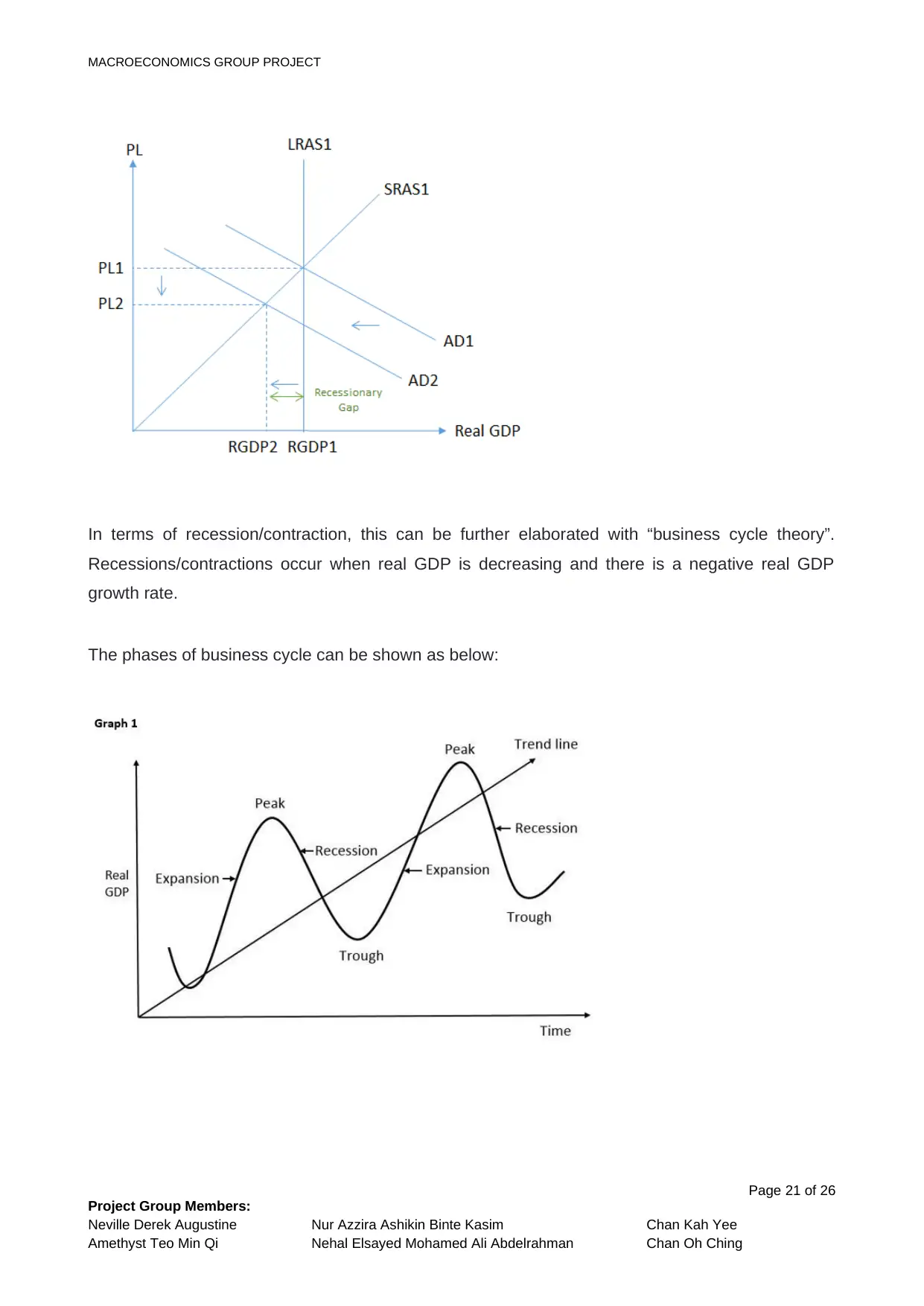
In terms of recession/contraction, this can be further elaborated with “business cycle theory”.
Recessions/contractions occur when real GDP is decreasing and there is a negative real GDP
growth rate.
The phases of business cycle can be shown as below:
Page 21 of 26
Project Group Members:
Neville Derek Augustine Nur Azzira Ashikin Binte Kasim Chan Kah Yee
Amethyst Teo Min Qi Nehal Elsayed Mohamed Ali Abdelrahman Chan Oh Ching
⊘ This is a preview!⊘
Do you want full access?
Subscribe today to unlock all pages.

Trusted by 1+ million students worldwide
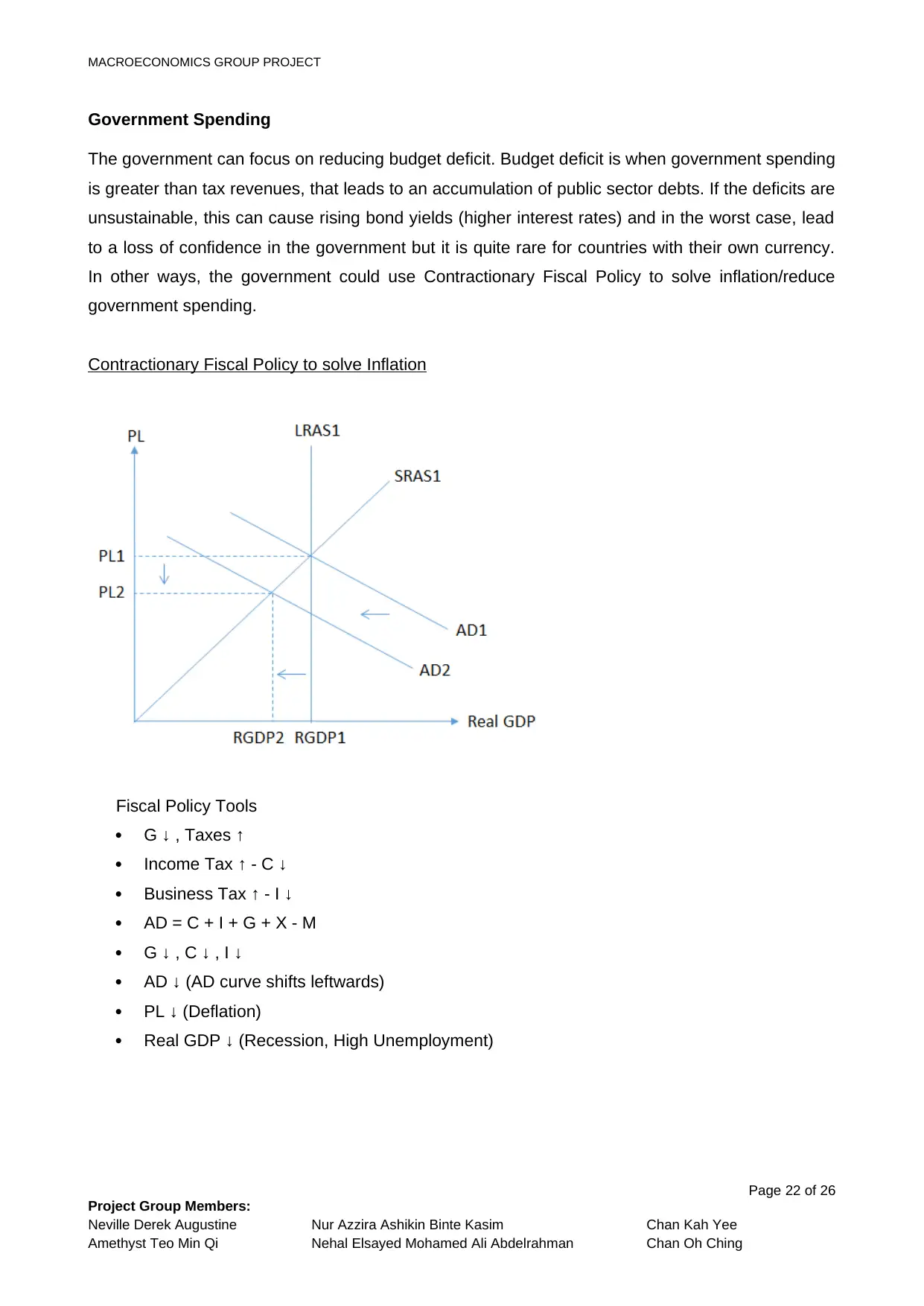
Government Spending
The government can focus on reducing budget deficit. Budget deficit is when government spending
is greater than tax revenues, that leads to an accumulation of public sector debts. If the deficits are
unsustainable, this can cause rising bond yields (higher interest rates) and in the worst case, lead
to a loss of confidence in the government but it is quite rare for countries with their own currency.
In other ways, the government could use Contractionary Fiscal Policy to solve inflation/reduce
government spending.
Contractionary Fiscal Policy to solve Inflation
Fiscal Policy Tools
G ↓ , Taxes ↑
Income Tax ↑ - C ↓
Business Tax ↑ - I ↓
AD = C + I + G + X - M
G ↓ , C ↓ , I ↓
AD ↓ (AD curve shifts leftwards)
PL ↓ (Deflation)
Real GDP ↓ (Recession, High Unemployment)
Page 22 of 26
Project Group Members:
Neville Derek Augustine Nur Azzira Ashikin Binte Kasim Chan Kah Yee
Amethyst Teo Min Qi Nehal Elsayed Mohamed Ali Abdelrahman Chan Oh Ching
Paraphrase This Document
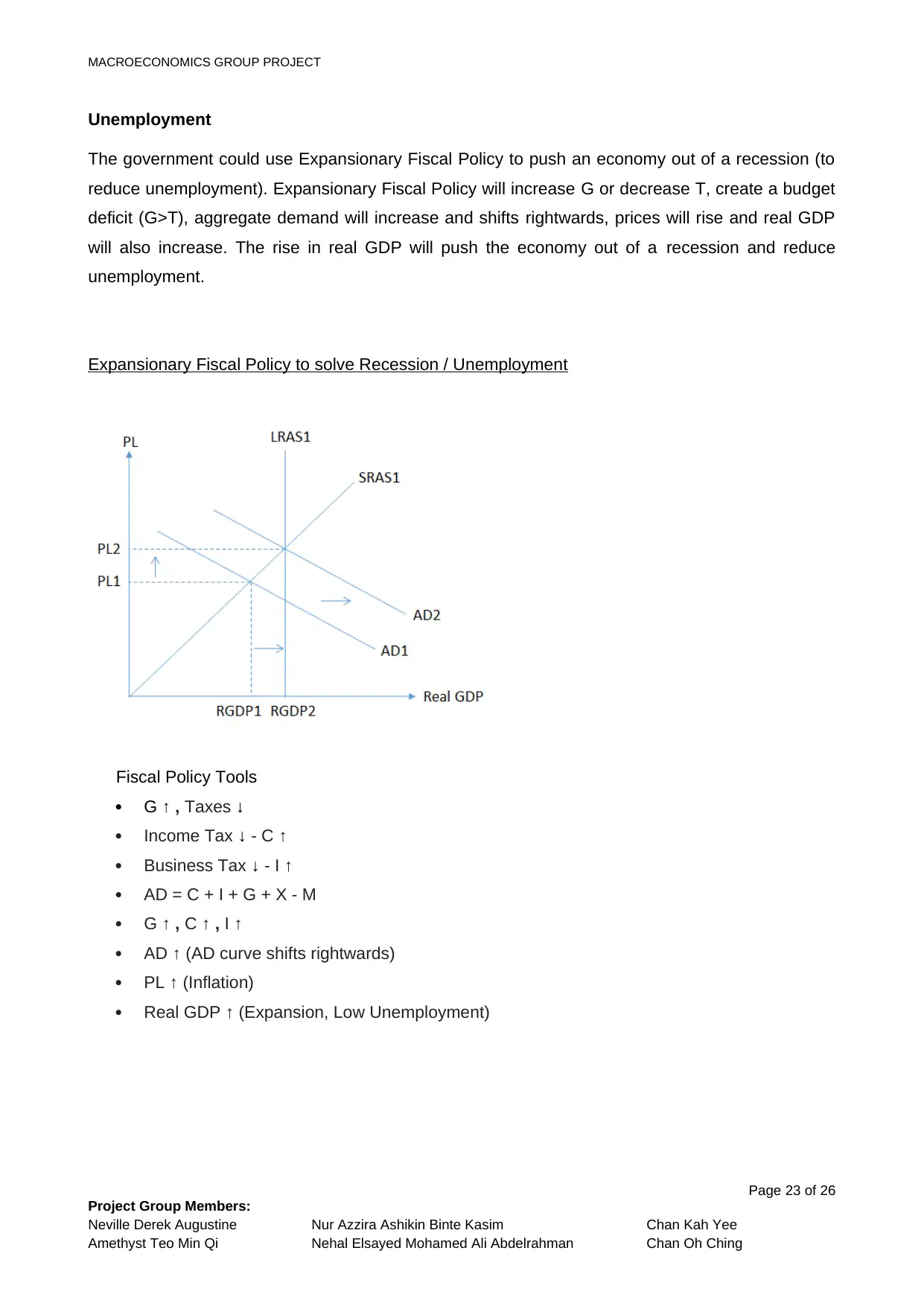
Unemployment
The government could use Expansionary Fiscal Policy to push an economy out of a recession (to
reduce unemployment). Expansionary Fiscal Policy will increase G or decrease T, create a budget
deficit (G>T), aggregate demand will increase and shifts rightwards, prices will rise and real GDP
will also increase. The rise in real GDP will push the economy out of a recession and reduce
unemployment.
Expansionary Fiscal Policy to solve Recession / Unemployment
Fiscal Policy Tools
G ↑ , Taxes ↓
Income Tax ↓ - C ↑
Business Tax ↓ - I ↑
AD = C + I + G + X - M
G ↑ , C ↑ , I ↑
AD ↑ (AD curve shifts rightwards)
PL ↑ (Inflation)
Real GDP ↑ (Expansion, Low Unemployment)
Page 23 of 26
Project Group Members:
Neville Derek Augustine Nur Azzira Ashikin Binte Kasim Chan Kah Yee
Amethyst Teo Min Qi Nehal Elsayed Mohamed Ali Abdelrahman Chan Oh Ching
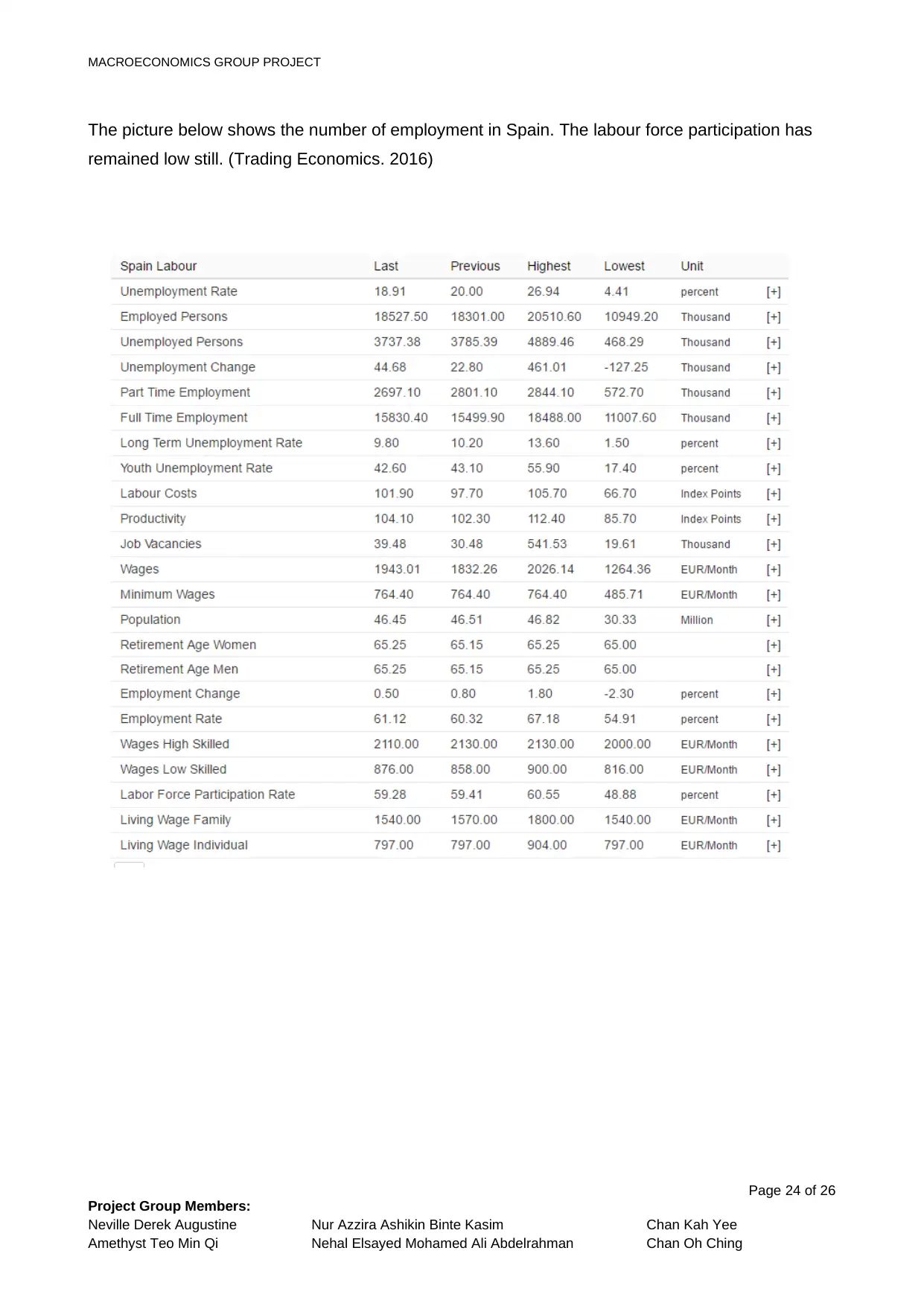
The picture below shows the number of employment in Spain. The labour force participation has
remained low still. (Trading Economics. 2016)
Page 24 of 26
Project Group Members:
Neville Derek Augustine Nur Azzira Ashikin Binte Kasim Chan Kah Yee
Amethyst Teo Min Qi Nehal Elsayed Mohamed Ali Abdelrahman Chan Oh Ching
⊘ This is a preview!⊘
Do you want full access?
Subscribe today to unlock all pages.

Trusted by 1+ million students worldwide
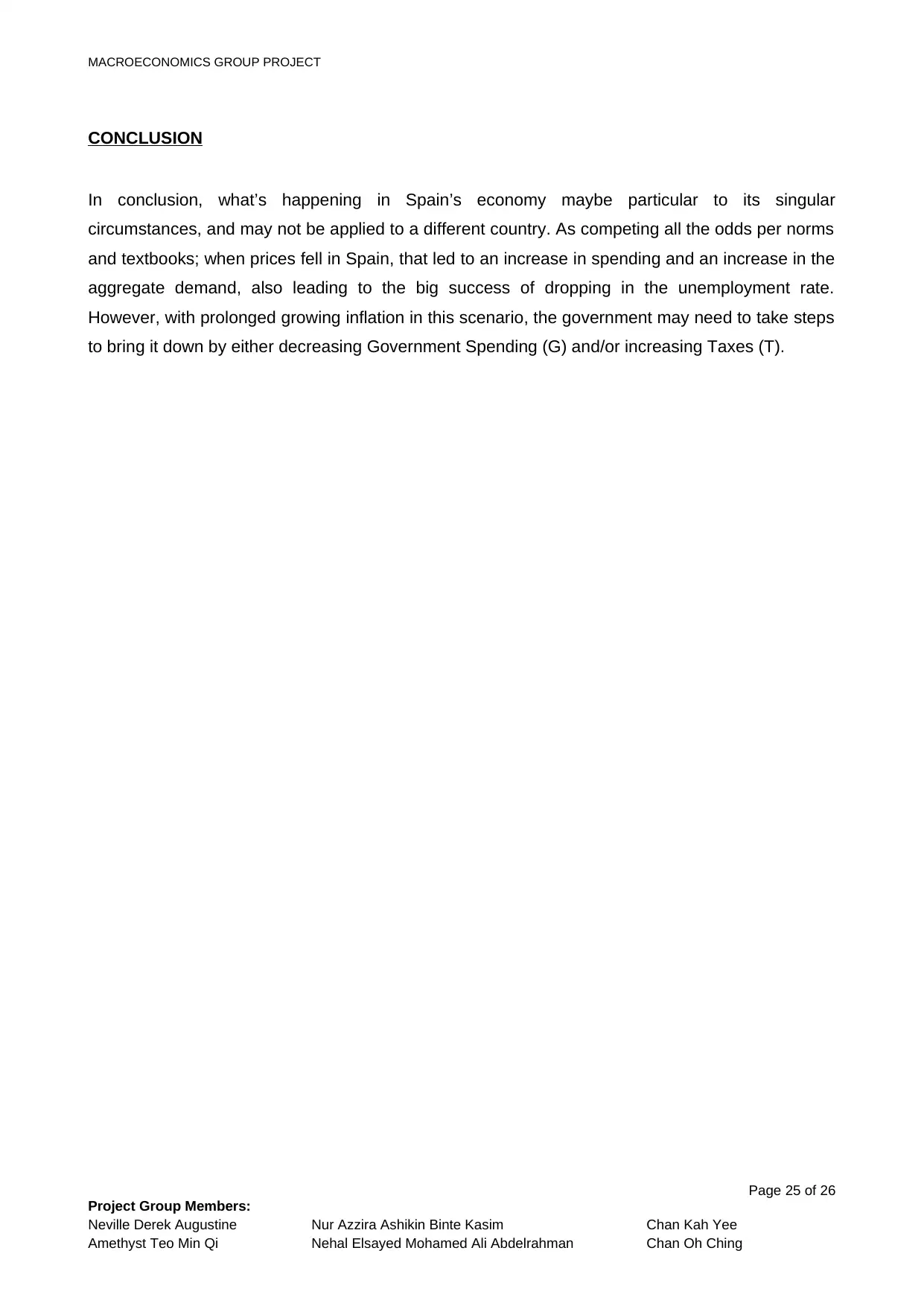
CONCLUSION
In conclusion, what’s happening in Spain’s economy maybe particular to its singular
circumstances, and may not be applied to a different country. As competing all the odds per norms
and textbooks; when prices fell in Spain, that led to an increase in spending and an increase in the
aggregate demand, also leading to the big success of dropping in the unemployment rate.
However, with prolonged growing inflation in this scenario, the government may need to take steps
to bring it down by either decreasing Government Spending (G) and/or increasing Taxes (T).
Page 25 of 26
Project Group Members:
Neville Derek Augustine Nur Azzira Ashikin Binte Kasim Chan Kah Yee
Amethyst Teo Min Qi Nehal Elsayed Mohamed Ali Abdelrahman Chan Oh Ching
Paraphrase This Document
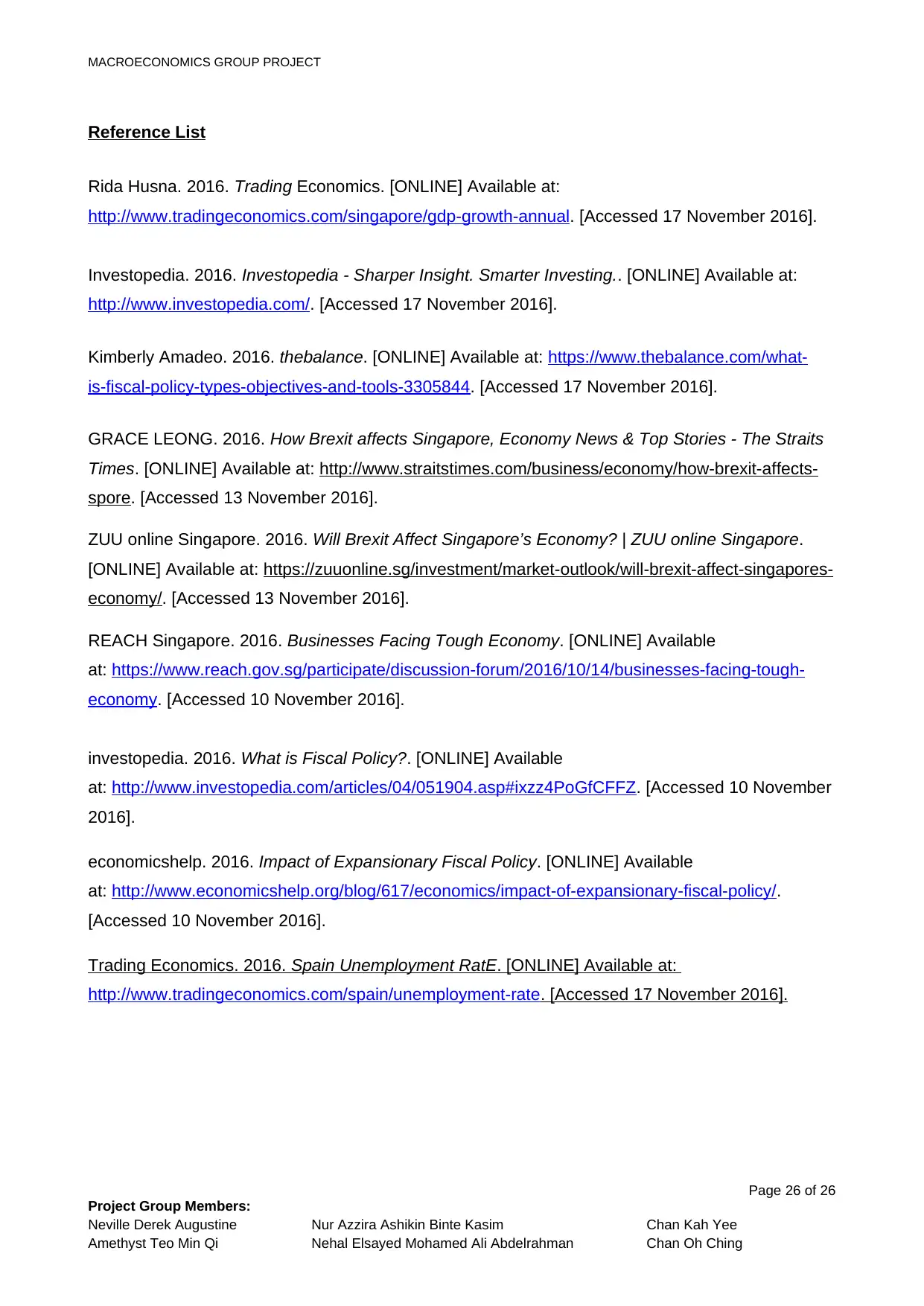
Reference List
Rida Husna. 2016. Trading Economics. [ONLINE] Available at:
http://www.tradingeconomics.com/singapore/gdp-growth-annual. [Accessed 17 November 2016].
Investopedia. 2016. Investopedia - Sharper Insight. Smarter Investing.. [ONLINE] Available at:
http://www.investopedia.com/. [Accessed 17 November 2016].
Kimberly Amadeo. 2016. thebalance. [ONLINE] Available at: https://www.thebalance.com/what-
is-fiscal-policy-types-objectives-and-tools-3305844. [Accessed 17 November 2016].
GRACE LEONG. 2016. How Brexit affects Singapore, Economy News & Top Stories - The Straits
Times. [ONLINE] Available at: http://www.straitstimes.com/business/economy/how-brexit-affects-
spore. [Accessed 13 November 2016].
ZUU online Singapore. 2016. Will Brexit Affect Singapore’s Economy? | ZUU online Singapore.
[ONLINE] Available at: https://zuuonline.sg/investment/market-outlook/will-brexit-affect-singapores-
economy/. [Accessed 13 November 2016].
REACH Singapore. 2016. Businesses Facing Tough Economy. [ONLINE] Available
at: https://www.reach.gov.sg/participate/discussion-forum/2016/10/14/businesses-facing-tough-
economy. [Accessed 10 November 2016].
investopedia. 2016. What is Fiscal Policy?. [ONLINE] Available
at: http://www.investopedia.com/articles/04/051904.asp#ixzz4PoGfCFFZ. [Accessed 10 November
2016].
economicshelp. 2016. Impact of Expansionary Fiscal Policy. [ONLINE] Available
at: http://www.economicshelp.org/blog/617/economics/impact-of-expansionary-fiscal-policy/.
[Accessed 10 November 2016].
Trading Economics. 2016. Spain Unemployment RatE. [ONLINE] Available at:
http://www.tradingeconomics.com/spain/unemployment-rate. [Accessed 17 November 2016].
Page 26 of 26
Project Group Members:
Neville Derek Augustine Nur Azzira Ashikin Binte Kasim Chan Kah Yee
Amethyst Teo Min Qi Nehal Elsayed Mohamed Ali Abdelrahman Chan Oh Ching
Related Documents
Your All-in-One AI-Powered Toolkit for Academic Success.
+13062052269
info@desklib.com
Available 24*7 on WhatsApp / Email
![[object Object]](/_next/static/media/star-bottom.7253800d.svg)
© 2024 | Zucol Services PVT LTD | All rights reserved.





